Technology
Poco C65/Redmi 13C phone review, price and specifications
Published
6 months agoon


Poco C65/Redmi 13C phone review. Check the price, technical specifications, camera, hardware, software, battery, charging speed and other features of Poco C65 phone.
Poco C65/Redmi 13C phone review, price and specifications
Introduction
If you’re looking for a low-cost Xiaomi experience, the Poco is the way to go, and if you want to spend your money on a Poco phone, there are the ‘C’ family devices to consider.
The Redmi 13C is a very similar device to the Poco C65, and in terms of hardware, they are practically identical. We’re pretty sure that the findings in this review apply to the Redmi 13C as well.
The Poco C series phones have been released frequently lately and the naming convention is difficult to decipher. It seems that the first number in the model number indicates the generation of the device, while the second number is somewhat related to its relative position in the product line, perhaps also its display size.
If we assume that this is indeed the case, then the new Poco C65 is the first of a new generation of Poco devices and will come to “replace” the Poco C55, even though the latter was launched in February this year. There are many similarities between the C55 and the new C65. Both devices are roughly the same size and feature a MediaTek Helio G85 chipset, a 5,000 mAh battery, and a 50-megapixel primary camera.


However, there are still some generational improvements to be noted. The screen on the C65, for example, has grown slightly and is now 6.74 inches in diameter. But more importantly, it can now refresh at 90Hz, a first for the Poco “C” line of phones. The Poco C65 now supports 18W PD charging, which may not sound like much in absolute terms, but it’s still a significant improvement over the Poco C55’s 10W.


The Poco C65 sweetens the deal with a new dedicated 2MP macro camera on the back, replacing the C55’s depth sensor. The selfie camera has also been upgraded to an 8-megapixel module. And when we say the Poco C65 is a budget device, we mean budget. It’s on sale for just $129 and $149 for the 6/128GB and 8/256GB models (original prices $109/$129).
Unboxing
The Poco C65 comes in a nice and sturdy two-piece box in the usual Poco yellow and black color scheme. Although the manufacturer doesn’t boast about being eco-friendly at all, the packaging appears to be made entirely of cardboard, which is great to see. There’s no built-in plastic stand for the phone to sit on, but it’s still quite securely in place.


The Poco C65 has a relatively rich retail package for its price. This will be a continuing motif with the C65 as it’s good to keep its low price in mind when analyzing different aspects of the experience. The retail box contains a USB Type-A to Type-C cable and a wall charger. It’s just a simple 10W (5V@2A) unit, not one that can saturate the full 18W of power a phone can accept. There’s nothing inside the box, but at this price point, that’s not really expected.
Design
Poco C65 has a very “traditional” design. Nothing out of the ordinary here, just your regular old phone that blends seamlessly into its surroundings.


The design team still tried to incorporate some distinctive details around the rear cameras with a raised area and some vertical lines. It all ties together well and looks classy. The only thing we don’t like about the back of the C65 are the manufacturer’s markings. I wish there was a better place for them.
The C65 is available in a total of three colors: black, blue and purple. Unfortunately, our review unit is probably the most boring black variant. The other two colors look more interesting.


The C65 has an almost completely flat back that sits flush with the midframe. Both of these are made of plastic. The sides of the phone are also completely smooth and have nice rounded corners for more comfort.


The windshield of the C65 is kind of “floating” on top of the middle frame. It’s well glued, of course, but instead of sitting in the middle frame like the back panel, it sticks out.


The C65 has very thick screen bezels, which is to be expected for its price. The lower chin is thicker than the upper frame. However, there’s plenty of room for multiple sensors and a selfie camera that still requires a display notch, but it’s relatively shallow.


Poco C65 is a very heavy device. Its dimensions are 168 x 78 x 8.1 mm and its weight reaches 192 grams. We’re not saying it’s tough or anything, but you’re still getting a big device with a 6.74-inch display and a 5,000mAh battery to boot.
Read more: Xiaomi 14 review, price and specifications
Poco C65 is quite solid and well made. There are no bends in the frame or hollows in the back.


As for materials, it’s no surprise that the C65 is made of mostly plastic. The back and middle frame are both plastic. Both still look like brushed metal from afar, so there’s that. The front of the C65 is fortunately covered with glass. Specifically, Corning Gorilla Glass. Although the manufacturer hasn’t specified exactly what kind it is, it’s great to hear that some protection is in place.
And as for peace of mind, while again there’s no official manufacturer information on the matter and the C65 lacks any official intrusion protection ratings, we did notice a nice thick rubber gasket on the SIM tray. This represents a minimum level of elemental protection. Although, we don’t exactly recommend trying it out for yourself.
Controls
The Poco C65 has a standard set of controls. Well, maybe, except for the 3.5mm audio jack, which is harder and harder. It’s alive and well and it’s at the top of the C65. There is nothing else on the top of the phone.


The left frame is also very empty. It only houses the SIM card tray. The C65 has a total of two nano SIM card slots in the said tray, along with a dedicated microSD memory expansion slot.


The opposite right side houses the volume and power buttons. The latter acts as a capacitive fingerprint reader. The reader is sharp and accurate. We have no complaints about it.


Both controls are well placed and comfortable to click. They feel a little soft to the touch, though they lack satisfying tactile feedback. This is a very minor inconvenience, though.


The bottom of the C65 is a bit more crowded. This is where the main microphone is next to the USB 2.0 Type-C port. The C65 has a single bottom-firing speaker. No stereo speaker setup here, not even a hybrid speaker.


At the end of the tour of controls, a phone is placed near the top of the phone in the space above the display. Proximity and light sensors are also located here.
Connectivity
The Poco C65 performs well in the connectivity department. Although, we should directly note that this is not a 5G device. Both nano SIM card slots on the phone support simultaneous 4G LTE connection.
The C65 also has dual-band Wi-Fi ac and Bluetooth 5.3. Although it does offer LE support. The C65 also has NFC in some markets. You should check with your local retailer for information on that. A receiver supports positioning with GPS, GLONASS, GALILEO and BDS. There is also an FM radio receiver with recording capability.


A USB Type-C port on the bottom can accept USB Power Delivery up to 18W and also supports USB Host/OTG. However, there’s nothing really fancy beyond that, like the video output. The Type-C port is backed up by a USB 2.0 connection, which means data transfer speeds of up to 480Mbps.
C65 has bma253 accelerometer but no gyroscope. The two are usually a combination. There is an ltr311 light sensor, but it is not paired with a hardware proximity sensor either. Instead, the C65 has a virtual proximity sensor that works well for turning off the screen, but is still far less preferable. There is also an mmc5603 magnetometer and compass combination on board. It is expected that there will be no barometer in the Poco C65.
Large 6.74-inch LCD, now with 90 Hz
Poco C65 is equipped with a very large LCD panel. Its diameter is 6.74 inches . As mentioned earlier, the C65 brings a high refresh rate to the Poco C family. It’s just your “base” 90Hz variation , but the difference between it and the standard 60Hz is still very noticeable, making it a much-appreciated addition.


Let’s start with some performance numbers first. The LCD panel in C65 is actually bright enough for an LCD. We measured about 480 nits of maximum brightness on the slider and 607 nits on auto maximum. The availability of an auto overshoot mode is great for bright environments, although the C65 is still difficult to use in direct sunlight.
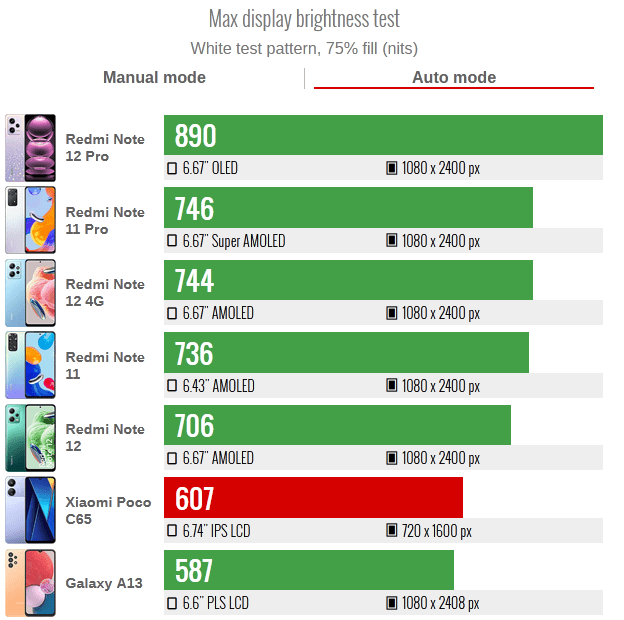

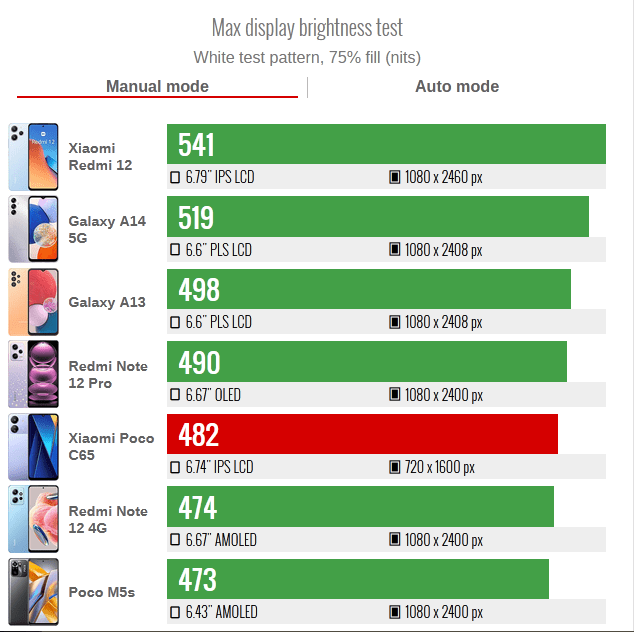

It is also worth noting that the screen in C65 is only with HD resolution ( 720 x 1600 pixels ). That’s spread a bit thin on the 6.74-inch 20:9 panel, which makes images a bit blurry. Nothing too extreme, but not exactly sharp either.
On colors, Poco C65 has a total of three color modes plus a color temperature adjustment wheel. Modes include Vivid, which is the default, Saturate, and Standard.
All three modes target the sRGB color space and cover it well. Vibrant and saturated modes have a slightly saturated blue color and cool the color palette. This is especially true for saturation. You can still get very accurate colors using standard mode. DeltaE values of 2000 are low enough to be considered color accurate.
Understandably, the C65 has no hardware HDR capabilities. However, it does support decoding for Dolby Vision. No HDR, HDR10+ or HLG though.






HDR modes • DRM info • Netflix streaming capabilities
On a more positive note, we’re happy to report that the Poco C65 supports the highest Widevine L1 DRM certification, allowing services like Netflix to offer FullHD streams. That’s frankly weird because it’s technically higher than the resolution on the phone’s own screen, but we’ll take it anyway.
High refresh rate control
The 90Hz refresh rate is an exciting new addition that makes its way to the affordable Poco C line with the C65. As we said, while 90Hz is more or less “basic” and “entry-level” refresh rate as high as you can get, it still makes a big difference in how smooth scrolling and animations feel.


To further sweeten the deal, the Poco C65 even has adaptive refresh rate switching logic. The phone has a total of three refresh rate modes – the default, which promises automatic switching between 90Hz and 60Hz, and then 90Hz and 60Hz modes. The 60 Hz mode is the simplest. It only offers a locked 60Hz experience. However, the 90Hz mode is not fixed at 90Hz. It’s dynamic and has logic down to 60Hz.
From what we can tell, the phone uses 90Hz for most user interfaces as long as you’re interacting with the phone or there’s movement on the screen. When neither is true, it drops to 60Hz to save power. Some apps, like most Google apps and some non-native apps like Facebook, always run at a fixed 60Hz. When it comes to video playback, the smartphone is smarter. Most multimedia apps like Gallery run at 90Hz in the UI, but once you start playing video, the phone is smart enough to recognize the scenario and drop it down to 60Hz.
Overall, we saw almost the same behavior using the Poco C65 at its default refresh rate. So, effectively, the phone only has two refresh rate modes.
It seems that high refresh rate games are prohibited on Poco C65. We tried a few games that we know can push past 60fps, and none of them were able to enable a 90Hz refresh rate regardless of the display’s refresh mode settings. The included Game Center also doesn’t offer refresh rate settings.








Playing with a high refresh rate is prohibited
All things considered, we like how the Poco C65 handles its automatic refresh rate switching. This behavior is smart and multi-faceted and saves battery very well. Playing with a high refresh rate on the phone is prohibited. Anyway, the chipset is a bit closed for power supply. Frankly, we couldn’t ask for more, especially from such an economical device.
The switching rate on actual pixels could be a little better. The C65 has a lot of ghosting and smearing while scrolling, especially in smaller text.
Battery life
The Poco C65 has a very large 5000 mAh battery. That being said, the MediaTek Helio G85 chipset isn’t exactly known for being the most energy-efficient part on the market. As you may know, we recently introduced the new GSMArena 2.0 battery test and the new Active Usage Score metric. You can read all about it here.
The Poco C65 performed very well in our battery test. Nothing spectacular, but still a strong show. It manages great call endurance numbers, and its video playback and web endurance aren’t half bad either. The game component leaves a little to be desired. This is very strange, considering that the phone can’t play continuously at 90Hz, which puts more pressure on the GPU. Plus, it only has HD+ resolution. However, we ran our numbers and retested, and we have another reason why the Poco C65 isn’t a great gaming phone.


Charging speed
One of the Poco C65’s upgrades over the C55 is support for 18W PD charging (compared to the standard 10W charging rate). Admittedly, this still doesn’t make the C65 a fast-charging device.


Fifteen minutes with a PD-compatible charger of sufficient wattage took our review unit from dead to just 14% battery. 30 minutes of charging resulted in 28% battery and full charging took 2:09 hours . To be fair, we’ve seen cheaper devices with slower charging speeds, but the C65 isn’t as fast as you might think.
Things look worse if you use the 10W (5V@2A) charger that comes in the phone’s retail box. With it, fifteen minutes of 11% charge, 22% for 30 minutes, and a full charge takes about 2:35 hours .
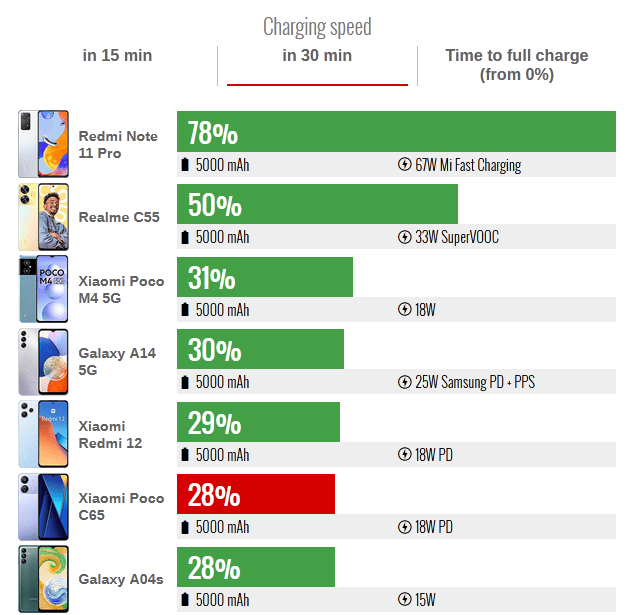

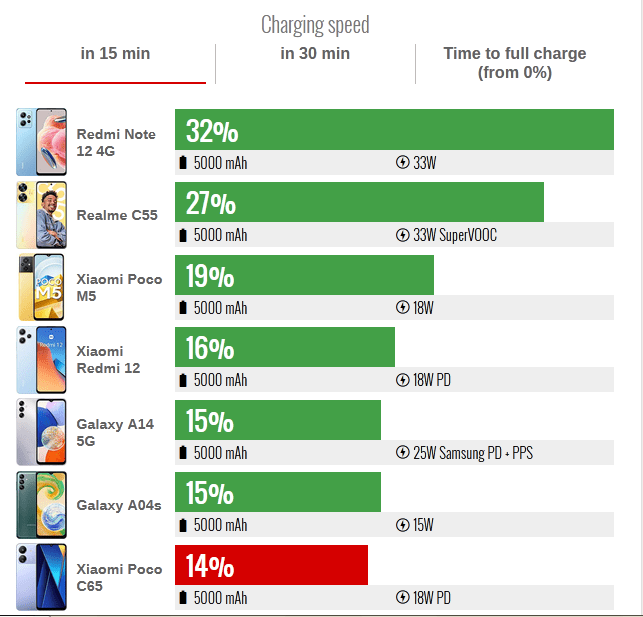

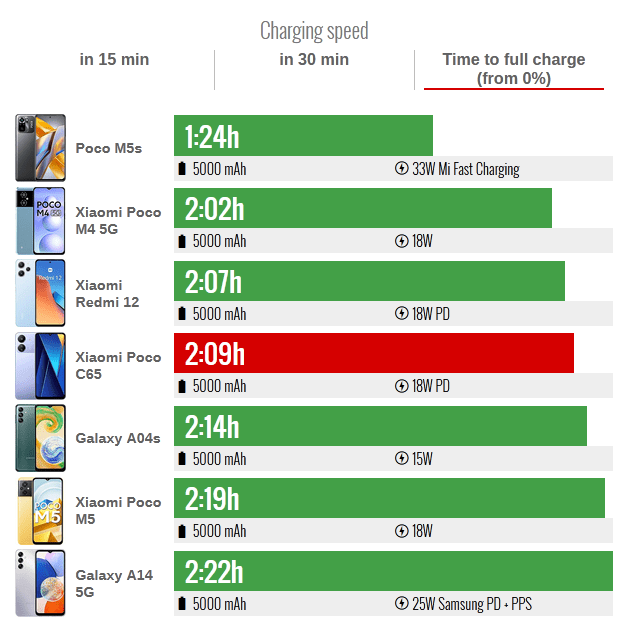

Speaker
The Poco C65 only has a single speaker that works at the bottom. There is no stereo setup, not even a hybrid. The single speaker is also not very impressive. In our test, the loudness score was below average . Its frequency response is decent, but nothing to call home. In particular, mids and voices are enough, and certainly an important part. Plus, we have to keep in mind how cheap this Poco C65 is and adjust our expectations accordingly.
In terms of additional audio features, the C65 has something called Voice Assistant . Its notable feature is volume adjustment per program while multiple programs are playing.
MIUI 14 for Poco on top of Android 13
At the time of writing this review, our Poco C65 unit is running Android 13 with MIUI for Poco 14.0.3. This is definitely a very current software combination. Although, we’re not sure what the future holds for Poco devices in regards to Xiaomi’s new HyperOS. There isn’t much difference between the standard MIUI and the iteration for Poco, so we suggest you take a closer look at your MIUI 14. You will find all the information you need there.


The only immediate difference between the standard MIUI and the Poco variants is in the default icon style. It seems to be more in line with Android’s circular icons.
MIUI for Poco also allows you to lock the screen by double-tapping an empty space on the home screen, whereas regular MIUI doesn’t. It also lacks the “large symbols” feature due to its value. We’re still not sure how Xiaomi will decide which features will make it to the global MIUI ROM, which will remain exclusive to the Chinese version, and which features the Poco will eventually receive. Everything is really complicated.


Apparently, MIUI 14 is built almost from scratch as architectural engineers have rebuilt the MIUI core ROM down to the Android kernel level. This includes new CPU, GPU, and memory scheduling, a smaller operating system size, and reduced memory usage overall. As a result, Xiaomi claims a 60 percent smoother experience and more optimized processes. Automatic compression for programs that are not actively used is also in the menu. Unfortunately, however, these are the features we can reliably test.
The split between the notification shade and Control Center isn’t enabled by default on our review unit, which is odd. By default, we got the standard combined notification menu and quick toggle menu.




Notification shade and fast switching
Home screen, recent apps and general settings remain unchanged. The app drawer is also enabled by default and cannot be disabled in Poco phones. We like the search bar at the bottom of the page for easier access. There are custom and preset app categories for faster navigation.
















Home screen, recent apps, settings menu, app drawer
MIUI recent apps list comes with some useful shortcuts. You can also choose whether the list of apps is vertical or horizontal. Interestingly enough, the sidebar and floating windows functionality seems to be completely absent from the Poco C65.
Themes have always been a big part of MIUI and they are available in MIUI 14 as well. You can download new ones from the Themes Store and they can change wallpapers, ringtones, system icons and even fonts.












Themes and other customization options
Moving towards privacy and security, MIUI comes with a pre-installed system security app. Aside from the extra layer of malware protection it provides, the app keeps many of the app’s settings and privacy features in one place. It can manage your blacklist, manage or limit your data usage, configure battery behavior and free up some RAM. It can also manage the permissions of your installed apps, define the battery behavior of selected apps, and apply restrictions to specific apps only.
All in all, MIUI 14 has changed little in terms of overall user experience compared to the 13th iteration, and that’s not a bad thing. Colorful and customizable as always.
Performance and benchmarks
Like the Poco C55, the new Poco C65 is powered by the MediaTek Helio G85 chipset. It’s a very old 12nm chip from 2020 that didn’t perform very well at launch and is starting to show its age today. There’s no use beating about the bush. The performance it delivers is disappointing all around.


In the CPU department, the Helio G85 has two large Cortex-A75 cores running at up to 2.0 GHz and six smaller Cortex-A55 cores running at up to 1.8 GHz. In terms of GPU, the Helio G85 only has two Mali-G52 MC2 cores to work with. In fact, there isn’t much power to go around. The Helio G85 is paired with 1800MHz LPDDR4X RAM.
Specifically, the Poco C65 comes in 6.128GB or 8.256GB trim, which is the unit we have for review.
Compared to the C55, which starts with 64GB of storage and 4GB of RAM, it’s a nice little upgrade, so we can’t complain too much. Although, it’s worth noting that the Poco C65 uses the slow eMMC storage type, which could explain its slow performance.
Let’s kick things off with GeekBench and some CPUs. It is easy to understand that the Helio G85 is not a powerful chip. That’s right, once again, we have to remind ourselves of the incredible price of the Poco C65. Still, however, the amount of performance available is kind of disappointing.
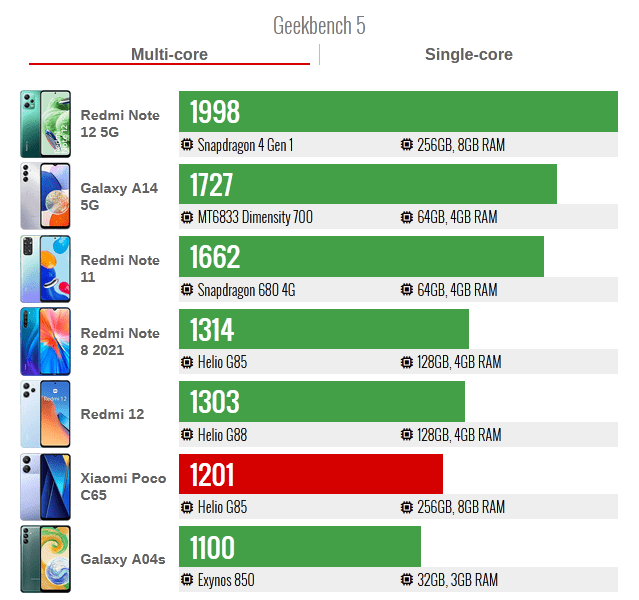
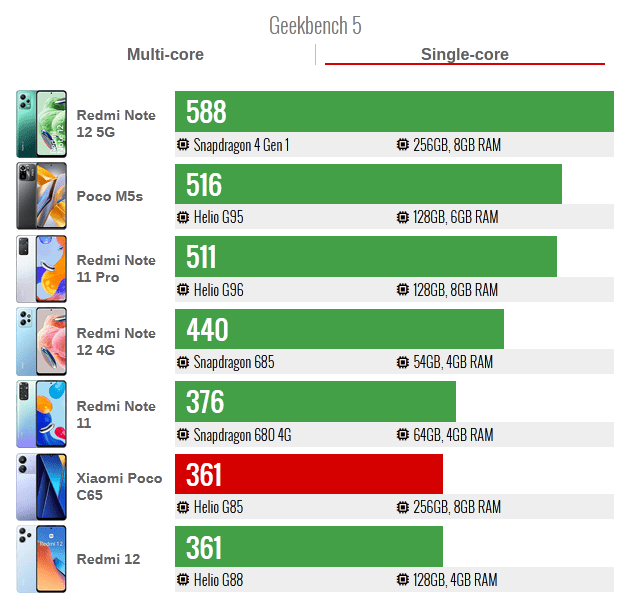

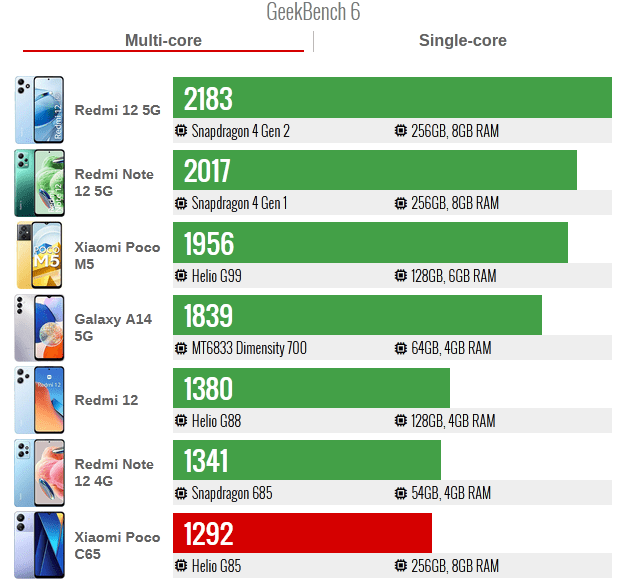
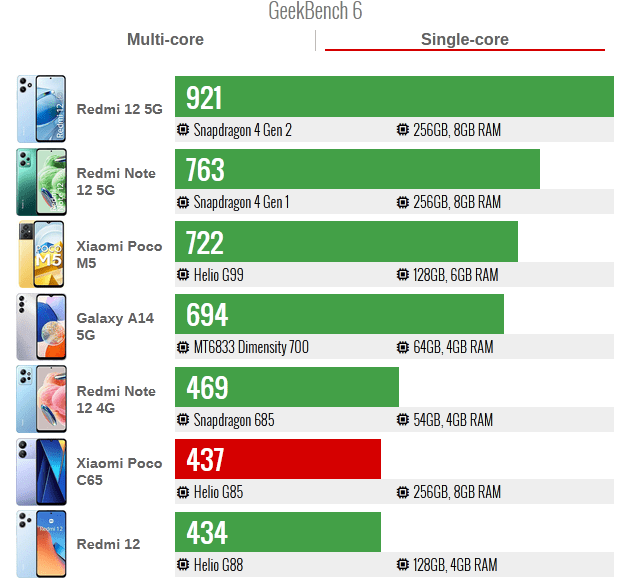

Even the Snapdragon 685 inside the Xiaomi Redmi Note 12 4G seems to offer slightly better performance than the Helio G85 in the Poco C65. It’s also worth noting that the older Redmi Note 8 2021 seems to fare slightly better on GeekBench with the same Helio G85 chipset. Not much, mind you, but still worth mentioning.
AnTuTu is slightly more favorable than the older Redmi Note 8 2021 and the Poco C65 in this comparison. However, the overall AnTuTu score is not impressive at all.
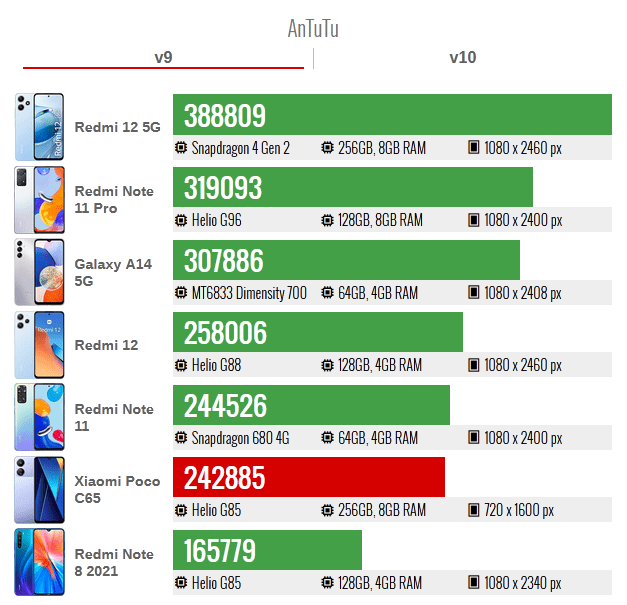

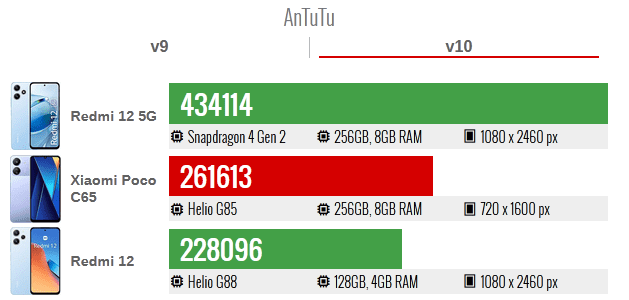

Our Poco C65 review unit stubbornly refused to connect to the GFXBench servers and run the benchmark. At least after fiddling for a while, it ran 3Dmark. As expected, the Mali-G52 MC2 GPU is pretty weak. At least you don’t have to work too hard to squeeze pixels onto the C65’s HD+ screen.
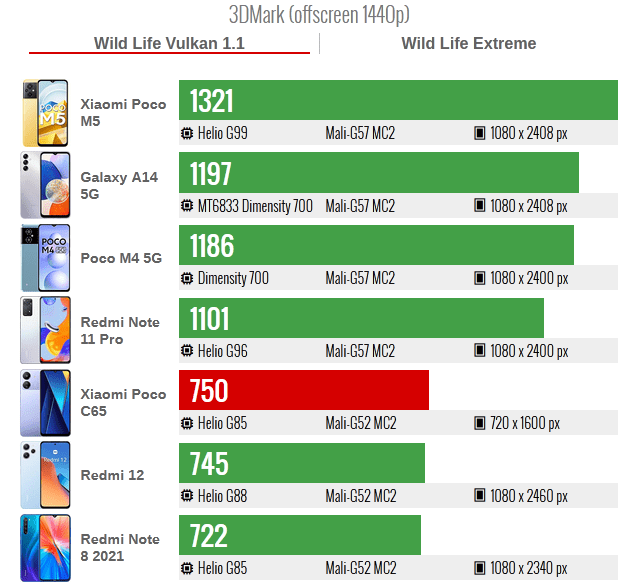

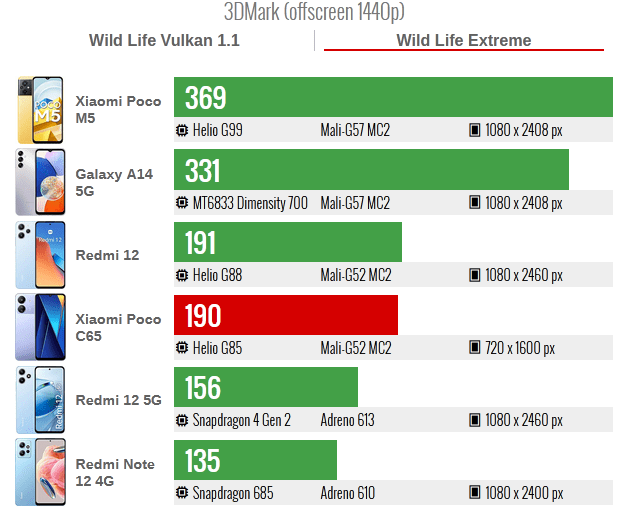

Unfortunately, the Poco C65 doesn’t just look bad in terms of performance. Even in practical terms, the phone is very slow and sluggish. The lack of smooth operation is one of the biggest problems with the Poco C65.
On the plus side, at least the C65 doesn’t overheat. Its surface is never uncomfortable to the touch, even with long-term stress testing. And the Helio G85 chipset inside isn’t very tasty either. It loses some performance with the torture test, but a very reasonable amount.
Xiaomi Android
50MP main camera and now a dedicated macro camera
Just like the Poco C55, the Poco C65 is equipped with a 50-megapixel main camera. It may be the exact same camera. We can’t say for sure because the Poco C65 supports two 50MP sensors – the OmniVision ov50d40, which has a 1/2.88-inch sensor size and 0.612µm individual pixels, and the Samsung s5kjns, which we assume is the JN1 with 1. 2.76-inch optical format and 0.64 µm individual pixels. Either way, the camera is 28mm wide, has phase detection autofocus, and sits behind an f/1.8 lens.


The Poco C65 also seems to have a third camera on the back. A very small one that the official website only lists as an “auxiliary” unit, whatever that means. We assume it’s some kind of depth sensor. However, covering it up doesn’t seem to affect the phone’s portrait photography capabilities.
Finally, we have the 8-megapixel selfie camera. The camera is based on the OmniVision ov8856 sensor with a 1/4-inch sensor size and 1.12 µm pixels. Behind is an f/2.0 fixed focus lens.
Camera app
The camera app is a simple implementation, though it has its own quirks. First, the main operation works for switching modes using a side swipe (on the black frame!), and you can also tap on the modes you can see to switch directly to it.
Up and down swipes do not work to switch between front and rear cameras. Only the button next to the shutter does this.
There is no More tab for modes on the C65. All modes are included in the original Rolodex.
There’s a pull-out menu at the top of the camera UI where you’ll find other options, including a macro mode that hasn’t been added to the main carousel of modes yet. Next to that, you have a flash mode switch, an HDR switch, and a shortcut for Google Lens. Oddly enough – like other Xiaomi devices, there is no Ai key.
Also, there is no Pro mode of any kind in Poco C65. Night mode is available on the main camera.
Day photo quality
The main camera of the Poco C65 takes photos with a resolution of 12.5 megapixels by default. The photos look nice enough, especially for such a budget device. The frame has a lot of detail and the colors are more natural and realistic.
However, the amount of sharpening is clearly visible, liberally applied, and there’s very little noise, especially on flat surfaces. Contrast is a little tricky and so is dynamic range. But again, keep in mind that this device is very affordable.
You can force the main camera to shoot at its full 50MP resolution . These photos don’t really look that different compared to their 12.5MP counterparts. The amount of detail is about the same, and the colors, contrast, and dynamic range are about the same. That being said, in 50MP mode, there seems to be less artificial sharpness applied to the frame, resulting in slightly softer but more natural-looking photos.












Poco C65: 50MP main camera samples
Here’s how the Poco C65’s main camera compares to the competition in our extensive camera comparison database. Pixel-peep away.




Poco C65 vs Samsung Galaxy A14 5G and Xiaomi Poco M4 Pro 5G in our photo comparison tool




50MP: Poco C65 vs Samsung Galaxy A14 5G and Xiaomi Poco M4 Pro 5G in our photo comparison tool
The main camera also takes very good portrait photos . Subject detection and isolation can be done almost at any time. We also like the quality of the background blur effect. Skin tones look convincing and completely natural.








Poco C65: 12.5MP main camera samples








Poco C65: 12.5MP main camera portrait examples
Unfortunately, even without applying a filter, there isn’t much skin texture in these portraits. However, this is a relatively minor problem.
Non-human subjects also work surprisingly well. The C65 has very little trouble picking out these subjects and focusing them correctly, something more expensive phones often struggle with.








Poco C65: 12.5MP main camera portrait examples
The Poco C65 does not have a dedicated ultra-wide or telephoto camera. However, the main camera has plenty of resolution for taking zoom shots . The camera app even has a 2x zoom switch, which shows that Xiaomi is confident enough about the phone’s zoom capabilities.
And indeed, these 2x zoom photos look very decent and look exactly like 1x photos. There is a lot of detail and the colors are beautiful.












Poco C65: 12.5MP main camera samples with 2x zoom
Some liberal sharpening is applied, bordering on oversharpening and contrast, and the dynamic range is excellent. However, these images are perfectly acceptable.
Finally, we have 2MP macro shots from the dedicated macro camera. These also look surprisingly good for what they are. Even with their low resolution, there is plenty of detail in the frame. Colors also look nice and match the main camera well, contrast is good, and the focal length is very wide and impressive.












Poco C65: 2MP macro camera examples
The Poco C65 selfie camera takes great 8MP photos. The detail is excellent and the skin texture is removed well. Colors and skin tones generally look nice and natural. Even contrast and dynamic range are both good.












Poco C65: 8MP selfie camera samples
The only real issue we found with these photos is, once again, the camera’s sharpening. Nothing too dramatic, though, and overall, these are some great selfies. The color surprised us.
Selfie portraits look equally great with excellent subject detection, isolation and a convincing background bokeh effect.












Poco C65: 8MP selfie camera portrait examples
Video quality
As we said earlier, the MediaTek Helio G85 is by no means an impressive chipset. This also applies to its video recording capabilities. As expected, video recording on the Poco C65 is limited to 1080p resolution. However, this is a norm at its budget price, so we can’t complain too much.


By default, the phone saves videos in a standard AVC (h.264) video stream at around 20 Mbps with AAC audio in an MP4 container. Unfortunately, the C65 only records mono audio for its videos. On the plus side, despite its budget nature, the Poco C65 still offers optional HEVC (h.265) video encoding. There is also an interesting option in the settings to automatically reduce the frame rate of videos in low light and high temperature environments. This is a very unusual option that you don’t see very often.
The Poco C65’s main camera shoots decent, if unremarkable, 1080p video. The level of detail is good, with regards to clarity, colors are beautiful and mostly natural.
The dynamic range is a bit narrow for our taste. The contrast is a little high, which results in an over-processed look. Overall, once again, considering the price of the phone, we can’t complain.
Here’s how the C65 compares to other devices in our video comparison database.




Poco C65 vs Samsung Galaxy A14 5G and Xiaomi Poco M4 Pro 5G in our video comparison tool
The C65 offers a quick switch for recording videos with 2x zoom . These look largely identical to the 1x examples, which is impressive in its own right. Again, we couldn’t realistically ask for much better from such a budget device.
The Poco C65 doesn’t appear to offer any form of EIS or other stabilization for its video. At least we did not manage to find such options. Here is an example of video from the main camera in motion. It is quite shaky as expected.
The selfie camera on the C65 is also limited to 1080p video recording. And, expectedly, just like the original camera, it only records mono audio, which is a bit of a bummer. However, in terms of quality, we can’t complain. The details are good and so are the colors.
Contrast is a bit too high, and dynamic range could be better, but these are relatively minor issues.
Camera quality in low light
The Poco C65’s main camera struggles significantly in low-light conditions. Photos look quite soft and noisy, with blown out highlights and light sources.








Poco C65: 12.5MP main camera examples in low light
Fortunately, there’s a dedicated night mode , which slows down processing a bit as expected, but offers a significant improvement in low-light quality.








Poco C65: 12.5MP main camera night mode samples
Night mode greatly reduces noise. Clarity is improved along with detail. Darker areas are much better managed. However, the biggest improvement should be to highlights and light sources. Night mode is the difference between a protruding clutter and usable real photos.
2x zoom shots from the main camera at night tend to look softer and more static than their 1x counterparts.








Poco C65: 12.5 megapixel main camera 2x the standard in low light
You can significantly improve their overall quality by using Night Mode, which has a 2x zoom shift.








Poco C65: 12.5MP main camera 2x night mode sample
Low-light selfies are not for a home phone. These are very soft and noisy. Most of the skin texture and fine facial features are completely lost. At least the skin tone looks quite realistic.








Poco C65: 8 megapixel selfie camera examples in low light
Unfortunately, night mode is not available for Poco C65 selfie camera.
Low-light video from the main camera is serviceable but mostly unimpressive. The amount of detail recorded is actually not bad for a 1080p video.
These videos are noisy and over-sharpened and over-saturated. The Poco C65 also struggles mightily with light sources.
Competitors
The Poco C65 is a really affordable device. There is no doubt about it. However, it seems a bit hard to pin down the exact retail price right now as there are a lot of sales going on. It looks like it will sell for just $129 and $149 for the 128/6GB and 256/8GB models respectively. Early bird pricing appears to be $109/$129.


Next up is the Xiaomi Redmi 12. It has a large screen like the C65 and LCD, but with FullHD+ resolution instead of HD+. The Redmi 12 also has an official IP53 ingress protection rating, notably an 8MP ultra-wide camera. The Redmi also has an IR blaster and uses the much better MediaTek Helio G88 chipset. Pricing is pretty similar between the two, which arguably makes the Redmi 12 the better deal in our opinion.








Redmi 12 • Redmi Note 12 5G • Redmi Note 12 4G • Samsung Galaxy A14 5G
Next, we recommend considering the ever-popular Redmi Note 12. It’s also slightly more expensive than the Poco C65, but it has an IP53 rating, a 120Hz AMOLED display and 33W charging. It also has an ultra-wide camera and an arguably better 1st generation Snapdragon 4 chipset.


If the Galaxy A14 is a little out of your budget, maybe consider the new Galaxy A05s. While most of its specifications are very similar to those of Poco C65. However, you get slightly faster 25W charging with the Galaxy.


If the Tecno is a bit out of your budget, then there’s the Infinix Smart 8. You’ll have to settle for a 13MP main camera, 10W charging, and a Unisoc T606 chipset.
Summary
Let’s keep things simple here. Xiaomi Poco C65 is a very affordable device. In fact, as far as trying to find good alternatives and competitors for it with the same value proposition. As such, its primary value will inevitably be price. The overall experience of the phone itself should be just good enough to meet the expectations of buyers at this low price.


The display offers a 90Hz refresh rate, which works well enough and is decently bright for an LCD. However, pixel response times aren’t perfect, leading to ghosting and smearing, and gaming at high refresh rates is a no-go. Battery life on the C65 is fairly good, but charging is very slow. MIUI 14 looks great and is feature-rich, but it stutters and slows down on the C65 due to the paltry Helio G85 chipset. The latter is also responsible for the camera’s 1080p video recording resolution, which is otherwise pretty decent for a budget device.


If we were shopping in this price range, we’d probably try to get something a little smoother than the Poco C65.
Why should we buy Poco C65 phone?
- Beautiful design with good build quality.
- A decently bright LCD with a 90Hz refresh rate.
- Good battery life
- Good camera performance in daylight
- expandable memory with dedicated microSD slot; A 3.5 mm audio jack
- Charger included in retail box.
Why should we avoid buying the Poco C65 phone?
- Virtual proximity sensor
- Loudness of the speaker is below average
- The Helio G85 chipset has poor performance with stuttering UI.
- Video recording is limited to 1080p and there is no stabilization.
Source: GSMARENA.COM


You may like
Technology
Unveiling of OpenAI new artificial intelligence capabilities
Published
1 day agoon
14/05/2024

OpenAI claims that its free GPT-4o model can talk, laugh, sing, and see like a human. The company is also releasing a desktop version of ChatGPT’s large language model.
Unveiling of OpenAI new artificial intelligence capabilities


Natural human-computer interaction
What exactly does the introduction of this model mean for users?
Strong market for generative artificial intelligence




Samsung S95B OLED TV review
What can be placed in a container with a depth of 4 mm? For example, 40 sheets of paper or 5 bank cards; But to think that Samsung has successfully packed a large 4K OLED panel into a depth of less than 4mm that can produce more than 2000 nits of brightness is amazing. Join me as I review the Samsung S95B TV.
Samsung has a very active presence in the smartphone OLED display market, and by the way, it also has some of the best and most stunning small OLED panels in its repertoire; But surprisingly, it has been a little more than a year since he seriously entered the OLED TV market; Of course, Samsung launched its first OLED TV in 2013 and quickly withdrew from the large-size OLED market and left the field to its traditional and long-standing rival, LG.
In the years after withdrawing from the OLED TV market, Samsung focused on the evolution of LCD TVs with technologies such as Quantum Dot and MiniLED; But after almost 10 years, Samsung decided to once again try its luck in the world of OLEDs, and thus, in 2022, it launched the S95B TV in two 55-inch and 65-inch models.
In 2023, Samsung introduced the S95C TV as a successor to the S95B and unveiled the S95D model at CES 2024; While Samsung’s 2024 TV has just been launched in international markets a few months after its launch, it is still hard to find its 2023 model in the Iranian market. Accordingly, we have prepared the 65-inch S95B model from 2022 for review. It is more numerous than the 2023 model in the market of the country.
Slim design… super slim
What draws attention to Samsung TV at first sight is not its eye-catching image and ear-pleasing sound, but its infinite slimness. The S95B was so slim that when I unboxed and installed it, I experienced the same level of anxiety I had on exam night! Samsung OLED TV is only 3.89 mm thick; For this reason, despite all the company’s efforts in strengthening the body, it still simply shakes and sways.

Samsung calls the ultra-slim design of its TV LaserSlim; Because the laser beam is narrow and sharp; So you should be very careful when installing the TV. I wish we knew what is the logic behind the childish efforts of companies to make the world’s thinnest TV. To some extent, the narrowness of the TV helps to make it more modern and better installed on the wall; But the strength of the TV should not be sacrificed to make it thinner.

Samsung designers have not spared even the edges of the TV! The width of the edges around the panel does not exceed 8 mm. The narrowness of the edges helps the user to immerse well in the depth of black and the extraordinary contrast of the OLED TV panel and enjoy the content to the fullest.

The S95B TV has a high-quality and well-made body, the frame of the device is metal, and like most OLED TVs in the market, there is a wide plastic protrusion in the lower half of which parts such as the board, speakers, and power supply are placed. Due to this protrusion, the thickness of the body reaches 4.1 cm in the maximum state.




Unfortunately, just like LG’s OLED TVs, the base of the S95B is also located in the middle of the device; Although the base itself is metal and relatively wide; the large dimensions of the TV and its very small thickness make it not to be firmly and firmly placed on the table and not to wobble; Of course, you can install the TV on the wall with a 300×200 mm VESA mount.


All the ports of the S95B TV, including HDMI and USB, are included in the plastic protrusion on the back of the device. These ports are covered with a plastic screen to integrate and beautify the back of the device. After installing it, surprisingly, you won’t be able to access the ports! Samsung TV ports are as follows:
- Four HDMI 2.1 ports with the ability to transfer 4K120 image signal; Two ports facing down and two ports on the side of the frame
- Two USB 2.0 ports on the side of the frame
- A network port
- Internal and external receiver input
- An optical audio output
One of the HDMI ports (number 3) has eARC capability and can be used to connect the device to the soundbar. USB ports are also different in terms of current and voltage; One of the ports is limited to 0.5 amps and 5 volts and the other is limited to 1.0 amps and 5 volts; Therefore, it is considered a more reasonable option for connecting an external hard drive.
Stunning brightness and disappointing color accuracy
I mentioned earlier that we had the 65-inch S95B model available for review. With such dimensions, you can enjoy the 4K resolution of the panel the most if you sit at a distance of about 2 meters from the TV; At closer distances, pixels can be separated, and at distances greater than 2 meters, your brain’s perception of a 4K image will be no different from a 1080p image.

The Samsung S95B TV uses a 10-bit OLED panel with a resolution of 4K or 2160 x 3840 pixels and can display more than a billion colors. Supporting this number of colors is essential to provide an optimal experience of HDR content playback. In the following, I will explain more about the compatibility of Samsung TVs with HDR standards and the quality of color display.
Unlike LCD panels, where the light needed by the pixels is provided by a number of LED lights on the edge or back of the panel, in OLED panels, each pixel provides its own light; As if instead of a limited number of exposure areas, for example 500-600 in MiniLED TVs, we have more than 8 million exposure areas; Thus, to display the color black, the pixels are turned off, so that instead of a spectrum of gray color, we see a deep black and experience an extremely high contrast.
 The absence of any Blooming thanks to the precise control of light in the TV’s OLED panel
The absence of any Blooming thanks to the precise control of light in the TV’s OLED panel
The great advantage of self-lit pixels (pixels that provide their own light) in displaying deep black and preventing the Blooming phenomenon (creating a halo around bright subjects in a dark background) thanks to the very precise control of the light distribution, also has some weaknesses; The greater vulnerability to burn-in phenomenon during long-term static image display and the lower level of OLED panel brightness compared to MiniLED samples are among these weaknesses.
Like other OLED TVs, the S95B TV is not immune to the risk of burn-in. In order to reduce the possibility of this phenomenon, the Koreans have considered solutions such as moving the image slightly in different time periods. Unfortunately, we do not have the possibility to examine the TVs for a long time to evaluate their performance in preventing the risk of burn-in; But at least based on RTINGS’ long-term and unrealistic test, the S95B seems to be more vulnerable compared to its competitors; However, in real use, it is unlikely that a user would want to watch TV with such intensity.
To overcome the inherent weakness of OLED panels in achieving higher levels of brightness, Samsung engineers have combined quantum dot technology with OLED panels. Quantum dots are very small crystal particles that are layered in the heart of the display panel. With the help of the quantum dot layer, the panels achieve higher brightness and produce more vivid colors. Samsung calls its combined panel QD-OLED and claims that with the help of the Neural Quantum processor in the heart of the S95B TV, this panel can raise the brightness to a higher level than its competitors.
|
Samsung S95B 65-inch TV brightness with default settings |
||||
|---|---|---|---|---|
|
Image modes/pattern white percentage |
10 percent |
50 percent |
100 percent |
|
|
SDR |
Dynamic |
1065 |
633 |
364 |
|
Standard |
740 |
487 |
281 |
|
|
Movie |
430 |
399 |
229 |
|
|
HDR |
Dynamic |
2094 |
— |
— |
|
Standard |
2179 |
— |
— |
|
|
Movie |
2179 |
— |
— |
|
|
FILMMAKER Mode |
2175 |
— |
— |
|
In my measurements, when only 10% of the screen was lit and the device was playing a normal SDR image, the brightness of the S95B panel reached 1100 nits in the highest mode, which is a very good number and better than the brightness of the C2 and C3 TVs in the same conditions, respectively. It is about 300 and 100 nits more.
Aside from the S95B’s excellent performance in SDR image brightness, the real magic happens when the device is playing HDR video. In this situation, when 10% of the screen is lit, the brightness reaches a stunning number of about 2200 nits, which is 700 nits more than the HDR brightness of the C2 and C3 TVs. Achieving such a level of brightness helps the TV to deliver a stunning HDR movie viewing experience.
|
Comparison of brightness and contrast of S95B with other TVs |
||
|---|---|---|
|
TV/parameter (the brightest profile) |
Brightness (50% pattern) |
contrast |
|
Samsung S95B |
633 |
∞ |
|
LG C3 |
603 |
∞ |
|
LG QNED80 |
580 |
116 |
|
LG NANO84 |
295 |
149 |
|
LG C2 |
525 |
∞ |
|
LG QNED96 |
470 |
— |
Note that the stunning numbers of 1100 and 2200 nits are obtained when a small part of the screen is bright, which is often the case in movies and series, and the entire image is not full of bright colors; But when the whole screen is lit; For example, consider a scene from The Lord of the Rings where we see Galadriel in the land of the elves, in such a situation, the maximum brightness of the whole screen is about 370 nits, which is still 40 nits higher than the LG TV.

Thanks to the panel’s excellent brightness and the deep blacks produced by the muted pixels, it’s no surprise that the Samsung TV’s image contrast is superb; Especially since there is an anti-reflective coating on the panel so that you can enjoy the image even in bright environments; Note that unlike what comes from the corners of the panel, you should not remove this anti-reflective layer from the panel; Otherwise, you will face problems like us!
If you think that the S95B is the best TV on the market so far, I must say that not everything about the S95B is rosy.
The S95B TV provides the user with the following four color profiles, all of which tend to be very cold by default and do not produce very accurate colors.
- Dynamic
- Movie
- Standard
- FILMMAKER Mode
Like most OLED TVs on the market, the S95B TV also covers a wide range of colors. In my tests, the Samsung TV managed to cover about 148% of the sRGB color space, nearly 100% of the DCI P3 wide space, and 75% of the Rec 2020 ultra-wide space. These numbers are great, But the disappointing thing is the very low accuracy of the device in producing the mentioned colors with factory settings.
|
Samsung S95B 65-inch TV performance in covering color spaces with default settings |
||||||
|---|---|---|---|---|---|---|
|
Image mode/color space |
sRGB |
DCI-P3 |
Rec. 2020 |
|||
|
cover |
mean error |
cover |
mean error |
cover |
mean error |
|
|
Dynamic |
146 |
— |
98.6 |
13.7 |
77.9 |
— |
|
Standard |
147.7 |
— |
99.7 |
12.1 |
78.7 |
— |
|
Movie |
125.4 |
— |
89.5 |
4.6 |
65.5 |
— |
|
FILMMAKER Mode |
121.9 |
— |
89.5 |
4.1 |
64.6 |
— |
Note that the FILMMAKER mode belongs to the UHD union and most big companies like Samsung, LG and Hisense use it in their TVs. On paper, with FILMMAKER mode, we should see movies as the director intended.
|
Comparison of Samsung S95B color accuracy with other TVs (default settings) |
||
|---|---|---|
|
TV/parameter (the most accurate profile) |
DCI P3 |
|
|
Covering |
Color accuracy |
|
|
Samsung S95B |
89.5 |
4.1 |
|
LG C3 |
96.8 |
3.0 |
|
LG QNED80 |
90.7 |
2.7 |
|
LG NANO84 |
82.9 |
— |
|
LG C2 |
98.7 |
2.1 |
|
LG QNED96 |
90.8 |
3.9 |
The most accurate colors of the S95B TV are depicted by the FILMMAKER Mode profile with an error of 4.1, in which the TV covers about 90% of the DCI P3 color space; As a comparison, in the review of the C3 TV, the color display error in the same FILMMAKER mode was 3.6 and in the most accurate color profile it was 3.0; Therefore, Samsung TV does not have an interesting performance in terms of factory calibration of colors.
We were so surprised by the results that we returned the TV and got another S95B to review, But the results did not change.
Fortunately, Samsung TV provides you with various settings to change parameters such as gamma, color temperature, color hue, and brightness limiter (ABL) so that you can achieve your desired style and style for displaying colors; For example, I was able to reduce the color display error in the Standard profile from a terrible number of 12.1 to a very good number of 3.0 by making the following changes.
|
Color accuracy of S95B TV after minor changes in panel settings |
|||
|---|---|---|---|
|
Image mode/color space |
DCI-P3 |
||
|
Settings |
Average error (recommended: less than 3) |
Color temperature (neutral: 6500 K) |
|
|
Standard |
default settings |
12.1 |
14236 |
|
ABL: Off Contrast Enhancer: Low Gamma: 2.2 |
3.0 |
8180 |
|
Another weakness of Samsung S95B TV compared to LG OLEDs is that it does not support HDR videos with Dolby Vision standard; The iPhone, for example, records HDR video using the same standard. Samsung TV supports HDR10, HDR10+, and HLG standards.

Like other OLED TVs, the Samsung S95B TV has wide viewing angles, and even from the corners, it displays colors with the least drop in freshness; So if you use wide furniture at home, you can safely go to S95B.
Samsung has focused a lot on the gaming capabilities of its TV; The device uses a 120 Hz panel with support for FreeSync Premium and G-Sync technologies, and the TV itself provides the user with Game Mode, which, by activating it, significantly reduces Input Lag, makes available a variable refresh rate, and The frames of the games can also be seen.

Samsung compensates for the visual weaknesses of the S95B TV with the amazing listening experience of its powerful speakers; While a TV like the LG C3 uses 40-watt speakers, Samsung engineers have used 60-watt speakers with a 2.2.2 channel combination in the S95B’s slim body; In the sense that two speakers throw the sound down, two speakers throw the sound up, and two woofers are responsible for producing low frequencies.
The S95B TV supports Dolby Atmos surround sound and its sound output is considered excellent for a TV; The volume is high, you can hear the pounding bass, and at high volumes, the distortion is controlled at a reasonable level.
Tizen; The user interface is more limited and different from competitors
Finally, we must avoid the TV user interface; Samsung’s OLED TV, like the rest of the company’s TVs, uses the Tizen operating system. The user interface of the device is smooth and smooth, moving between different menus of the user interface is done without problems, although sometimes with a little slowness; But the device can play most of the video formats.




A number of functions are also available, which doubles the enjoyment of the TV experience, provided that the user uses a Samsung phone; For example, you can run the Samsung phone’s desktop mode or Dex on the TV and use the phone’s screen as a trackpad. The phone can even be used as a webcam to make video calls with Google Mate on the TV.
If you want to write a text, you can call Microsoft365 from the Workspace section of the user interface by connecting a Bluetooth mouse and keyboard to the Samsung TV and start writing in Microsoft Word software.

Samsung Internet Browser is available in the S95B TV user interface; But the Samsung remote control, despite its compact design and the possibility of being charged with a solar panel or USB-C port, does not have the ability to use a mouse; So you have to browse the web with the arrow keys of the remote control; In my opinion, this is one of the main weaknesses of Samsung TV compared to LG TV with its practical magic remote.



As another weakness, we should mention Samsung’s not very rich store; For example, you can’t find some useful apps like Spotify or native apps like Filmo in the Samsung TV store.
Read more: How to connect to the TV with a Samsung phone?
Without a doubt, the S95B is one of the most stunning TVs we’ve ever reviewed on Zoomit; An attractive and extremely slim device that will amaze you with its stunning brightness and contrast, impressive gaming capabilities, and very powerful speakers.
In terms of factory color calibration, the S95B appears below expectations and a bit disappointing; So, if you are not very fond of the image and do not know much about color parameters, you will have to start with inaccurate and very cold colors; But if you are aware of the color parameters, you can change them and enjoy the attractive picture of the TV to the fullest.

The S95B TV is one of Samsung’s 2022 flagships, and now its 65-inch model is sold in the price range of 105 million Tomans; In this range, go for the more updated LG C3 TV with more accurate colors, or for a little more money, choose the Sony A80L TV for 2023, which is powered by a more practical Android operating system; In addition, C2 TV is also available at a price of 10 million less than in 2022.
what is your opinion? Do you think the S95B is a reasonable choice or do you prefer other models from LG or Sony?
Pros
- Very high brightness
- 6 powerful speakers
- Very modern and attractive design
- Deep black and excellent contrast
Cons
- Low color accuracy with default settings
- Too thin and vulnerable body
Technology
MacBook Air M3 review; Lovely, powerful and economical
Published
1 week agoon
06/05/2024

MacBook Air M3 review; Lovely, powerful and economical
If you are looking for a compact, well-made and high-quality laptop that can be used in daily and light use, the MacBook Air M3 review is not for you; So close the preceding article, visit the Zomit products section and choose one of the stores to buy MacBook Air M1 ; But if you, like me, are excited to read about the developments in the world of hardware and are curious to know about the performance of the M3 chip in the Dell MacBook Air 2024 , then stay with Zoomit.
The design is a copy of the original from the last generation
Almost two years have passed since Apple said goodbye to the familiar and wedge-shaped MacBook Air design; A different design that accompanied this ultrabook from the first day of its birth in 2008; But finally in 2022, with the aim of harmonizing the design language of the Apple laptop family, it was abandoned so that the MacBook Air 2022 will have a similar appearance to the 14-inch and 16-inch MacBook Pro.
The new MacBook Air is uniform in thickness; But it was slimmer, the screen was bigger, the edges were narrower and the corners were rounded, and a relatively large notch was added to it, whose only existence was to host the device’s 1080p webcam. MacBook Air 2022 also marked the return of the MagSafe magnetic charging port to Apple’s popular Ultrabook.
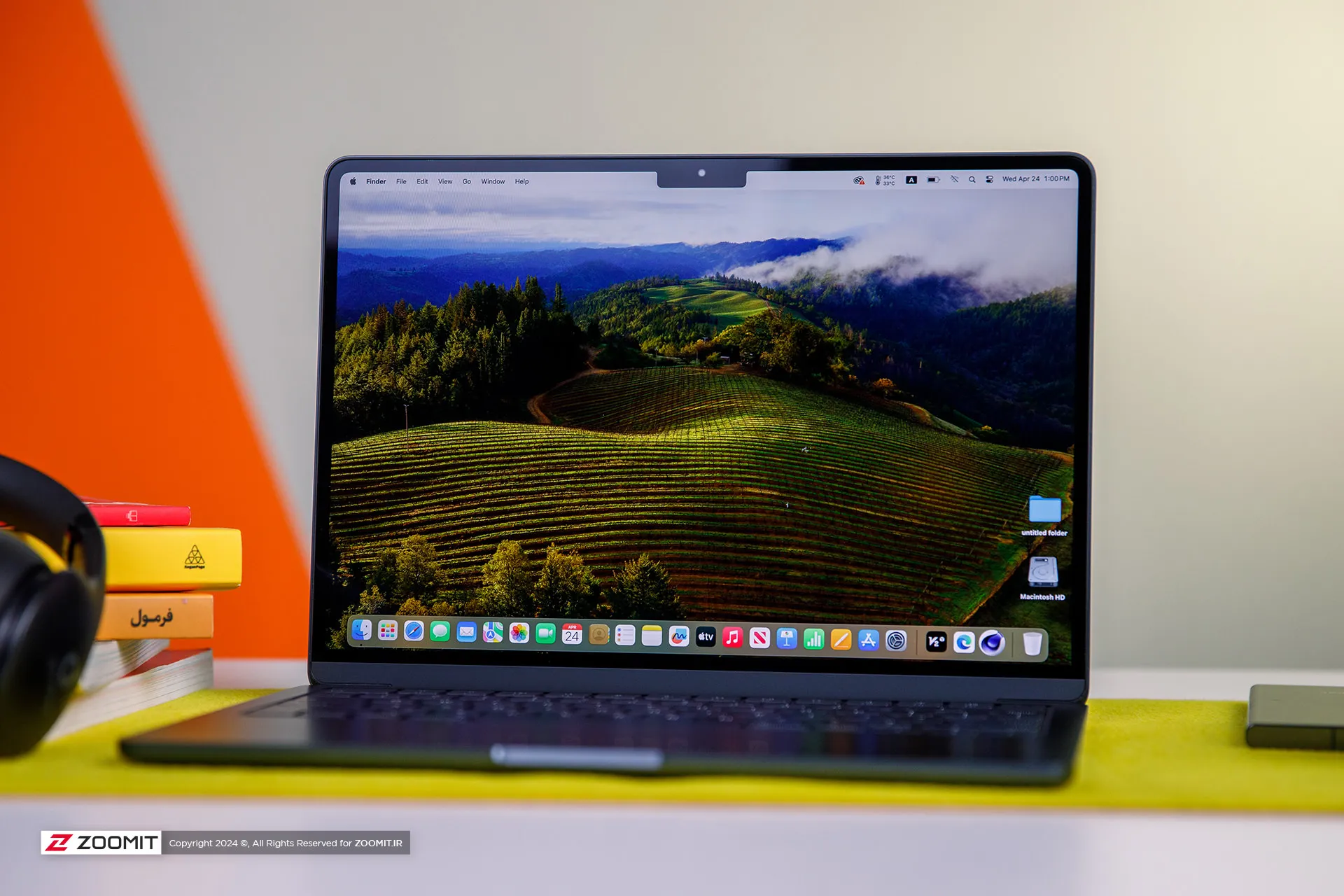
Previously, in the review of the MacBook Air 2022 with the M2 chip, we have talked comprehensively and deeply about its design and its positive and negative points. I suggest that if you haven’t read the article, you must visit it; Because the MacBook Air M3 is no different from the MacBook Air M2 in terms of appearance, display, or ports.
We also see the same incredibly well-made and metal body of MacBook Air 2022 in the new generation of Apple Ultrabooks; A body that, like the rest of Apple laptops, is carved from an aluminum block instead of the usual method of using aluminum sheets, and for this reason, it has a strong and dense structure so that we do not see the body sinking when pressing the keyboard area or the screen frame swinging.



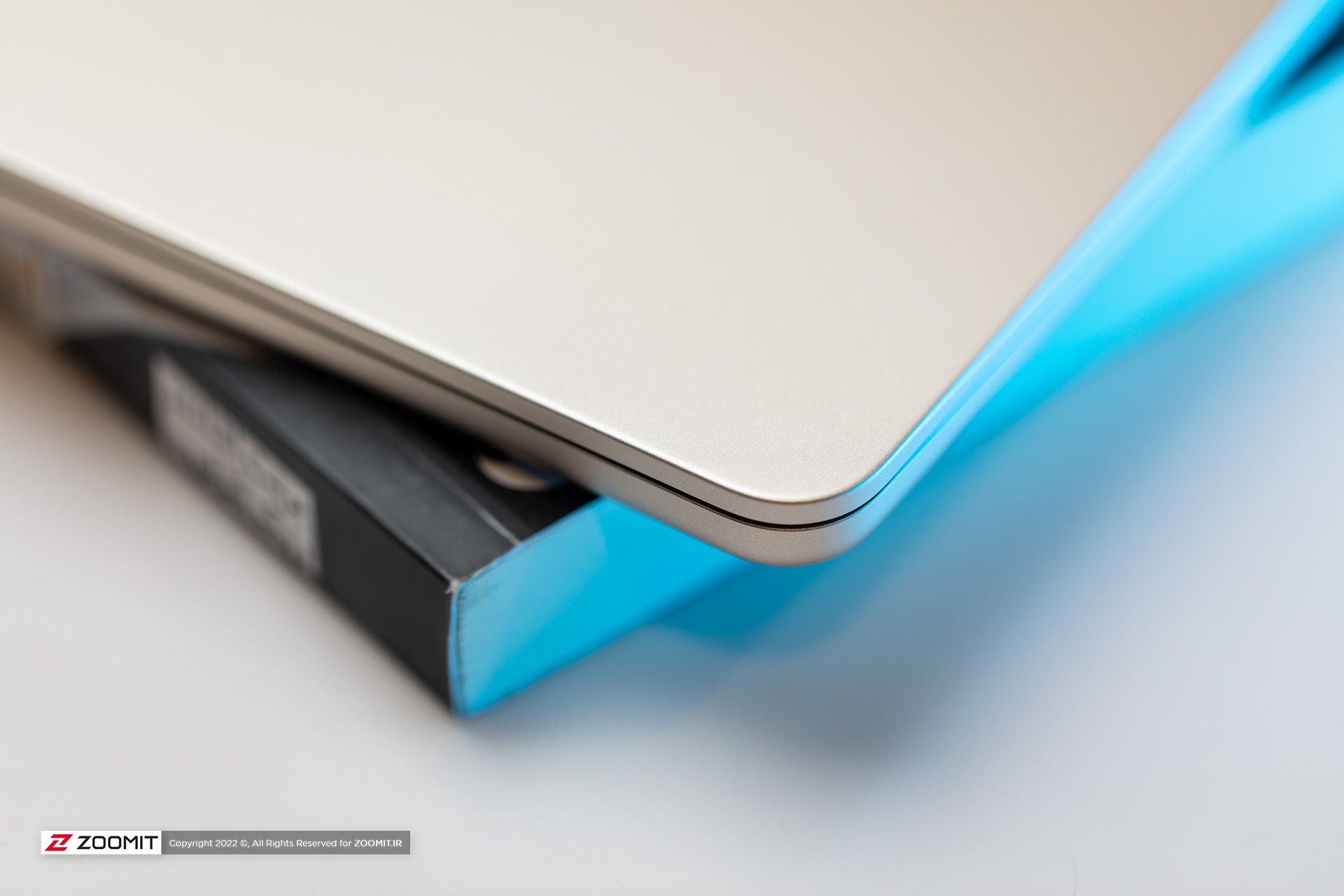
All the parts of the MacBook Air 2024 are assembled with the utmost care; So that there is no gap between them. As expected, the hinge of the laptop is also well-adjusted so that you don’t need to use two hands to open the laptop door. All in all, the combination of the quality of components and Apple’s exemplary engineering precision, brings an extremely enjoyable and unique feeling to the user while using the MacBook Air.
Just like the previous generation, the new MacBook Air is sold in four colors: gray, silver, dark blue, and cream. One of the flaws that could be found in the design of the MacBook Air 2022 was that fingerprints and grease remained on the body; The item that was more noticeable in dark blue color. Apple says this year it has used a new coating that reduces the severity of this problem. We did not have the 2022 model available for comparison at the time of writing the following review, But traces of fat and finger still remain on the body of the MacBook Air 2024.
 Grease and fingerprints on the laptop body
Grease and fingerprints on the laptop body
MacBook Air keyboard is among the best examples in the market in terms of arrangement and dimensions, feedback, and key stability; But the matte coating on the keys absorbs the fat of the fingers very quickly, and on the other hand, like other MacBooks, there is a possibility that the matte coating will disappear and the keys will become shiny. Depending on your usage, this can happen very quickly or over time; For example, for me, who is constantly writing, the keys on my MacBook Pro M1 burned out in less than a year.
Apparently, the buyers of used laptops are very sensitive about the keys being electrocuted; Therefore, if you plan to replace your Macbook with another laptop after one or two years, be sure to keep this in mind and use an external keyboard for long typing.
As always, the trackpad is one of the main strengths of any MacBook, and the MacBook Air M3 follows the same rule. The glass trackpad of the device is large in size and has little friction on its surface, it offers flawless, accurate, and smooth performance, and its Fortouch mechanism, which makes it possible to click on the entire surface of the trackpad, is so efficient that after the MacBook, it is impossible to work with the trackpad of any laptop. Another enjoyed.
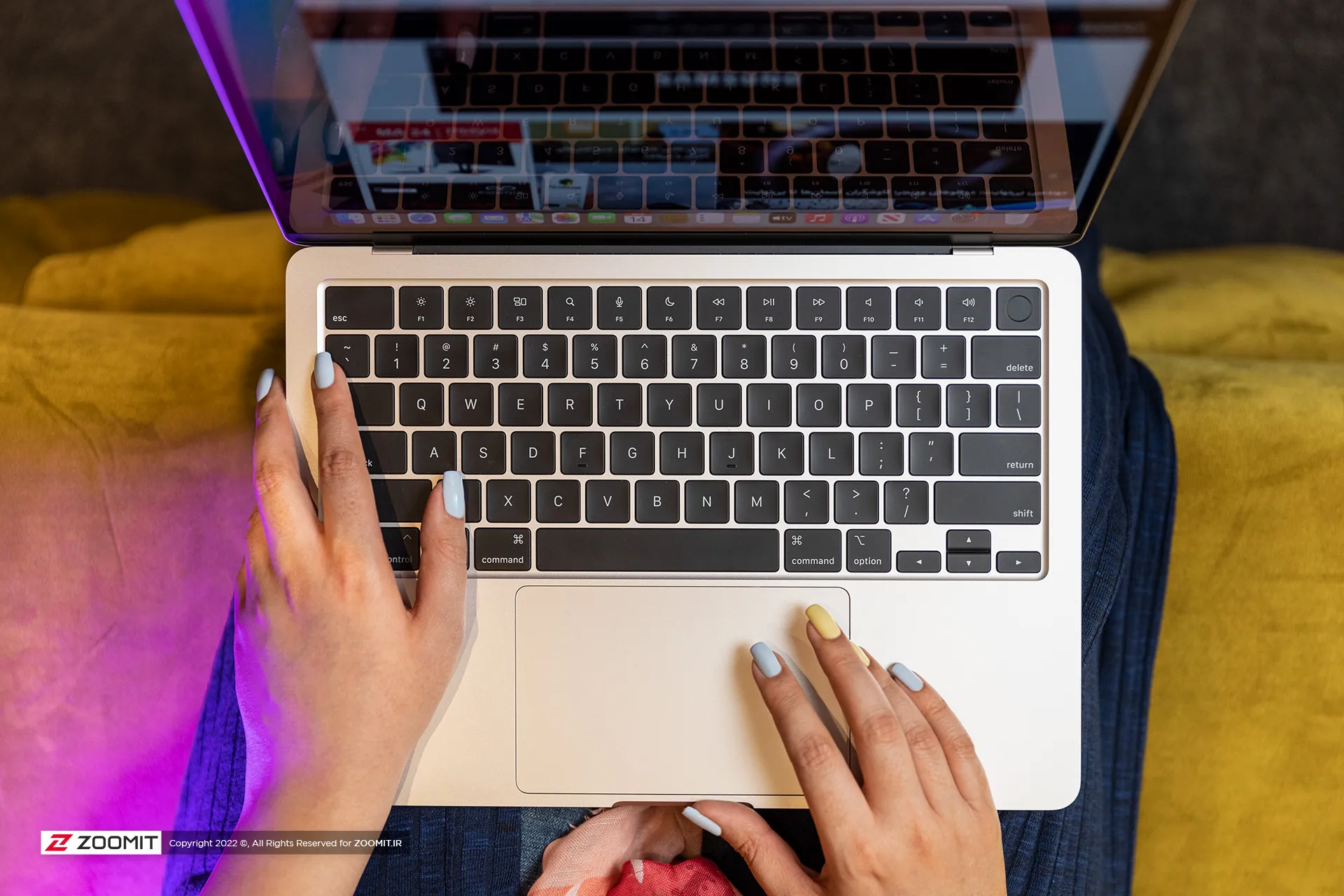 MacBook Air 2022
MacBook Air 2022
The set of MacBook Air 2024 ports is limited and has not changed; On the right side of the device, there is a headphone jack, and the left side of the device hosts two USB4 ports and a MagSafe magnetic charging port. Along with the basic model, Apple provides a relatively small 30-watt adapter with a cloth cable of the same color as the device’s body; But you can also get the laptop with a more powerful 35 or 70-watt adapter, which charges the battery up to 50% within half an hour.
USB4 ports support Thunderbolt 3 standard with a bandwidth of 40 Gbps, But it is not possible to connect external graphics. Both ports also transmit the image signal with the DisplayPort standard. In the new MacBook, if you close the laptop door, you can connect a 6K monitor and a 5K monitor (both 60Hz) to the device at the same time; But with the laptop’s screen on, just like the MacBook Air M2, the image output is limited to a 6K monitor; It is interesting that the Intel version of MacBook Air could output images to two 4K monitors at the same time as its own screen is on!
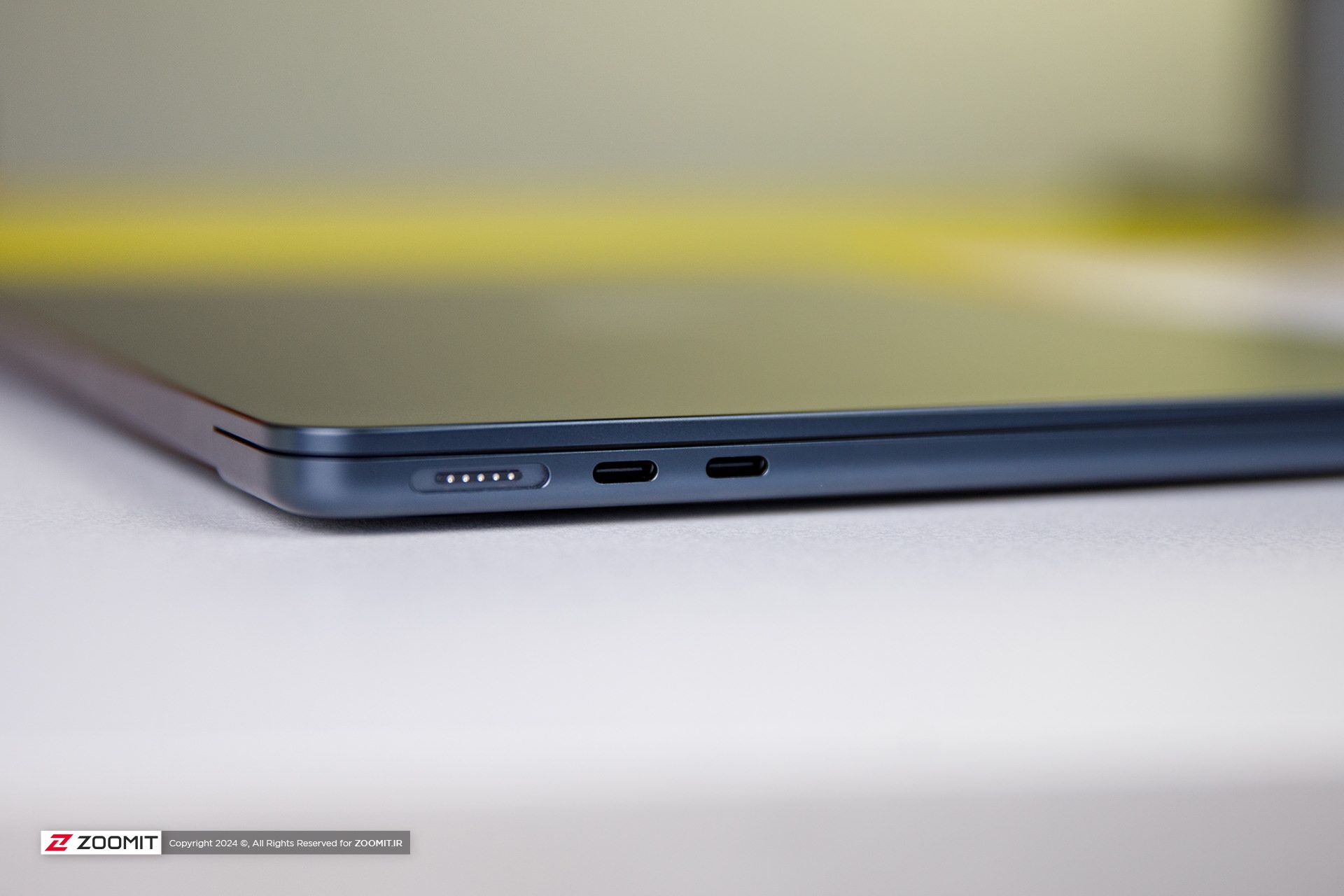
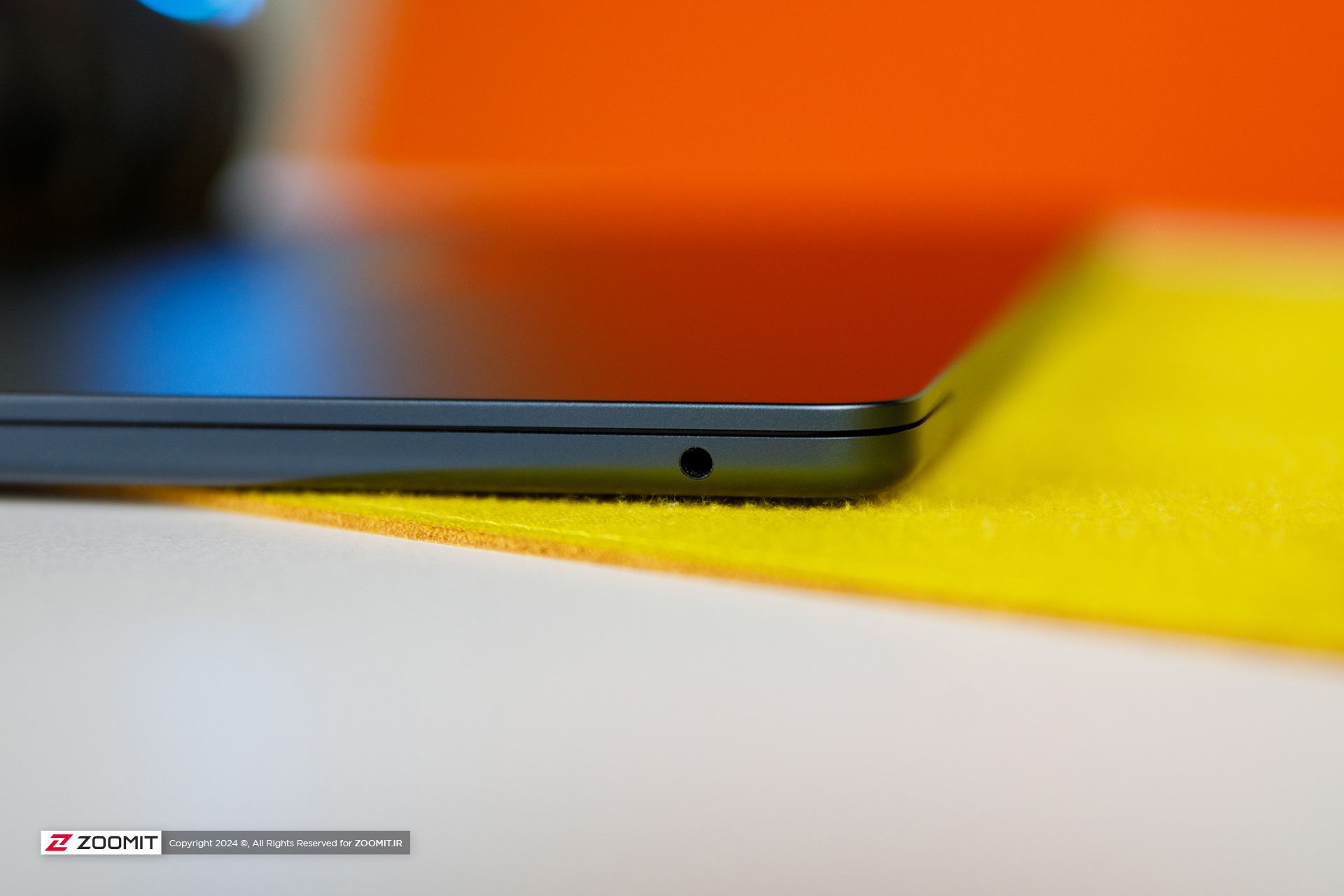
As in the previous generation, Apple uses Bluetooth version 5.3 in its Ultrabook; But the Wi-Fi module has upgraded the device from Wi-Fi 6 to Wi-Fi 6E, which incompatible networks can increase the communication bandwidth of MacBook Air 2024 with the router and the rest of the devices in the network from 1.2 to 2.4 Gbps.
Attractive display with more attractive competitors
Like most parts of the device, the screen of the new MacBook Air does not change; Of course, in this field, you can’t criticize Apple much, since 2018, when the MacBook Air screen became Retina, it has always been among the best; However, today, with OLED competitors with stunning colors and infinite contrast, Apple’s Retina display no longer has its former glory.
MacBook Air M3 can be purchased just like the previous generation in two 13.6-inch and 15.3-inch models. The pixel density of both versions is a very good number of 224 pixels. With this density, the MacBook Air screen produces a very clear image. So that it is difficult to distinguish the pixels from each other. We have the 13.6-inch MacBook Air M3 with a resolution of 2560 x 1664 pixels available for review.

Unfortunately, unlike the expensive models of MacBook Pro or even Windows Ultrabooks with the same price as Zenbook, the panel of the MacBook Air is 60 Hz and it does not have amazing technologies such as OLED and MiniLED to produce 1000 nits of brightness and extraordinary colors. MacBook Air uses an 8-bit IPS LCD panel with back exposure, which, by using FRC technology, can give the user the feeling of 10-bit panels with a billion colors.
MacBook Air covers the wide DCI P3 color space with high accuracy. The Apple Ultrabook covers 98.4% of this space with an error of 1.9 (an error of less than 3 is ideal), perhaps the only color weakness of the panel can be considered a slight tendency to be cold; However, thanks to the True Tone feature, the device evaluates the ambient light temperature with high accuracy and adjusts the color temperature accordingly to give you a satisfying visual experience.
In our measurements, with a 50% raster standard, we reached a maximum brightness of 443 nits, which in itself is a very good number, and thanks to the anti-reflective coating on the panel surface, in environments with different light conditions, it brings a satisfactory experience of working with a laptop. Without the appearance of the shadow of the environment on the panel, the user will not be bothered.
|
MacBook Air 2024 screen performance against other laptops |
||||||||||
|---|---|---|---|---|---|---|---|---|---|---|
|
Laptop / test |
White image |
Black image |
contrast ratio |
AdobeRGB |
sRGB |
DCI-P3 |
||||
|
Maximum brightness |
Minimum brightness |
Average brightness |
Native |
cover |
Average error |
cover |
Average error |
cover |
Average error |
|
|
MacBook Air 2024 |
443 intentions |
0.00 nits |
0.67 nits |
661 |
87.9 |
— |
100 |
2.4 |
98.4 |
1.9 |
|
Zenbook 14 |
512 intention (788 nits HDR) |
0.27 nits |
0 intentions |
∞ |
89.6 |
2.6 |
100 |
0.6 |
99.7 |
1.3 |
|
MacBook Pro 2022 |
437 intentions |
0.00 nits |
0.5 nits |
874 |
86.3 |
— |
99.8 |
2.7 |
97.5 |
— |
|
MacBook Air 2022 |
447 intentions |
0.1 nit |
0.65 nits |
693 |
87.5 |
— |
100 |
2.5 |
98.1 |
— |
|
Galaxy Book 3 Ultra |
441 intentions |
4 intentions |
0 intentions |
∞ |
97.3 |
3.7 |
99.6 |
1.9 |
99.8 |
2.3 |
|
MacBook Pro M1 Max |
455 intentions (1497 nits HDR) |
0 intentions |
0 intentions |
∞ |
85 |
— |
121.6 |
— |
97.3 |
2.5 |
In addition to the reasonable maximum brightness of 442 nits in bright images, unlike most laptops with IPS LCD screens, the black color brightness is also very low in the MacBook Air display; So that the device achieves a very high contrast. On the other hand, the minimum brightness of the display was 0 nits even with the 0.01 nits accuracy of the Zoomit luminance meter; In the sense that while using the laptop, there will be a little pressure on your eyes.
The attractive screen of the MacBook Air is completed by a set of 4 speakers; Speakers that have a very large sound volume compared to the size of a laptop, produce clear sound, and at high volumes, they are confused and distorted. MacBook Air speakers support Dolby Atmos and are easily ahead of most Windows laptops.
M3 chip and championship called TSMC
The main changes of MacBook Air 2024 have happened in its heart; Where it hosts the M3 chip as the beating heart of the device. Next, before we put the performance of the M3 under the microscope, we take a look at the details of the technical specifications of this chip.
The M3 chip is manufactured using TSMC’s 3nm-based manufacturing process known as N3B, hosts 25 billion transistors on its surface, and uses the same layout and configuration as the M2 for the CPU and GPU cores. Apple says the processor and graphics used in the M3 are about 35 and 65 percent faster than the M1, respectively.
|
Technical specifications of M3 against M2 and M1 |
|||
|---|---|---|---|
|
parameters/chip |
Apple M3 |
Apple M2 |
Apple M1 |
|
manufacturing process |
3 nanometer N3B TSMC |
TSMC’s second-generation 5nm |
5 nm N5 TSMC |
|
CPU |
4 powerful cores with a maximum frequency of 4.05 GHz 4 low-power cores with a maximum frequency of 2.75 GHz |
4 Avalanche cores with a maximum frequency of 3.5 GHz 4 Blizzard cores with a maximum frequency of 2.4 GHz |
4 Firestorm cores with a maximum frequency of 3.2 GHz 4 Icestorm cores with a maximum frequency of 2.0 GHz |
|
cache memory |
16 MB shared L2 cache and 320 KB L1 cache for each of the powerful cores 4 megabytes of shared L2 cache and 192 kilobytes of L1 cache for each low-power core 8 MB system cache for the entire chip |
16 MB shared L2 cache and 320 KB L1 cache for each of the powerful cores 4 megabytes of shared L2 cache and 192 kilobytes of L1 cache for each low-power core 8 MB system cache for the entire chip |
12MB shared L2 cache and 320KB L1 cache for each Firestorm core 4 MB shared L2 cache and 192 KB L1 cache for each Icestorm core 8 MB system cache for the entire chip |
|
memory bass |
128 bits |
128 bits |
128 bits |
|
DRAM |
8 to 24 GB LPDDR5-6400 |
8 to 24 GB LPDDR5-6400 |
8 or 16 GB LPDDR4x-4266 |
|
Memory bandwidth |
100 GB per second |
100 GB per second |
68.2 gigabytes per second |
|
GPU |
8 or 10 cores with hardware support of ray tracing |
8 or 10 cores |
7 or 8 cores |
Like the last two generations, the M3 chip uses a combination of 4 high-power cores and 4 low-power cores, respectively, with maximum frequencies of 4.05 and 2.75 GHz as CPU. Apple has made minor changes in the architecture of the cores, and the main difference of the cores is the 15% increase in frequency compared to the M2 cores.
Apple has not even changed the amount of cache memory of the M3 chip compared to the M2; Each of the high-power and low-power cores have access to 320 and 192 KB of ultra-fast L1 cache, respectively, the set of four high-power and low-power cores also have access to 16 and 4 MB of L2 cache, respectively, while the system cache is 8 MB for the set of chip processing blocks. GPU and CPU are included.
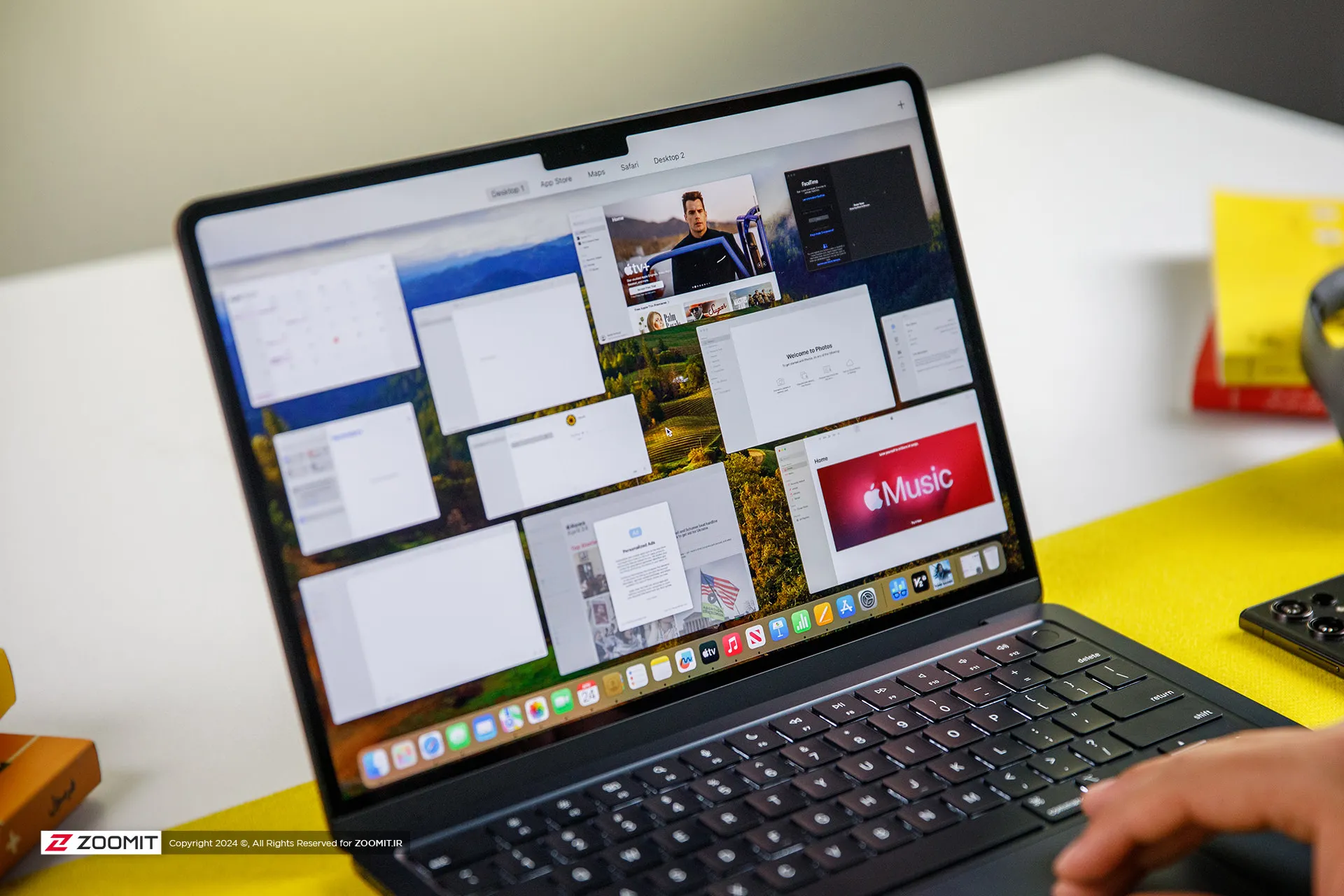
The M3 chip is used in Apple laptops in two versions with 8- and 10-core graphics processors. We had the MacBook Air with 8-core graphics available for review, which in total, just like the last generation, has 128 execution units with 1024 calculation and logic units in its heart, which operate at an almost identical frequency of 1.38 GHz.
The main difference between the M3 graphics compared to the previous generation is the addition of the Ray Tracing hardware accelerator, Mesh shading, and Dynamic Caching technology, the latter of which allows the chip to provide the memory required by the GPU in real-time and based on the type of processing. Thus, it optimizes the amount of memory consumption.
The M3 chip uses a 16-core neural processing unit (NPU) with a computing power of 18 trillion operations per second, and in addition to ProRes and ProRes Raw videos, it now has a separate engine for AV1 video codec decoding. Due to its two 64-bit channels and support for LPDDR5X-6400 RAM, this chip can achieve a bandwidth of 102 GB/s for data exchange with its integrated RAM.
|
Performance of the MacBook Air M3 in benchmarks while plugged in |
||||||
|---|---|---|---|---|---|---|
|
Laptop/benchmark |
Technical Specifications |
Web browsing |
Performance in graphics |
CPU performance in rendering |
CPU computing power |
GPU computing power |
|
3 Dark |
CineBench R23 |
GeekBench 6 |
GeekBench 6 |
|||
|
Speedometer 2.1 |
TimeSpy |
Single Multi |
Single Multi |
OpenCL Metal/Vulkan |
||
|
DirectX 12 |
||||||
|
MacBook Air 2024 |
Apple M3 8 core GPU |
680 |
— |
1897 9872 |
3143 2008 |
25845 41671 |
|
Zenbook 14 |
Core Ultra 7 155H Intel Arc GPU |
396 |
3453 |
1637 13367 |
2290 12256 |
34889 38268 |
|
MacBook Pro 2022 |
Apple M2 10-core GPU |
407 |
— |
1579 8730 |
2581 9641 |
28852 42673 |
|
MacBook Air 2022 |
Apple M2 8 core GPU |
405 |
— |
1577 8476 |
2578 9655 |
27846 39735 |
|
MacBook Pro 2020 |
Apple M1 8 core GPU |
209 |
— |
1512 7778 |
2335 8315 |
21646 32743 |
|
MacBook Pro 14-inch 2021 |
M1 Max 24Core GPU |
300 |
— |
1549 12508 |
2378 12239 |
65432 101045 |
MacBook M3 appears about 20-25% faster than M2 in single-core and multi-core benchmarks, and in comparison with M1, it increases its superiority to about 35-45%; Therefore, considering the 15% increase in frequency and the improvement of TSMC’s manufacturing process, it seems that Apple has not changed much in the architecture; But in any case, CPU performance on par with the M1 Pro is a surprising result for the M3.
Compared to the new Asus ultrabook with the Core Ultra 7 155H chip, MacBook Air M3 leads by 15-35% in single-core benchmarks; But in multi-core benchmarks, it loses the field to the competitor with a single-digit difference of up to 25%. We will talk more about the difference between the two chips in productivity and power consumption.
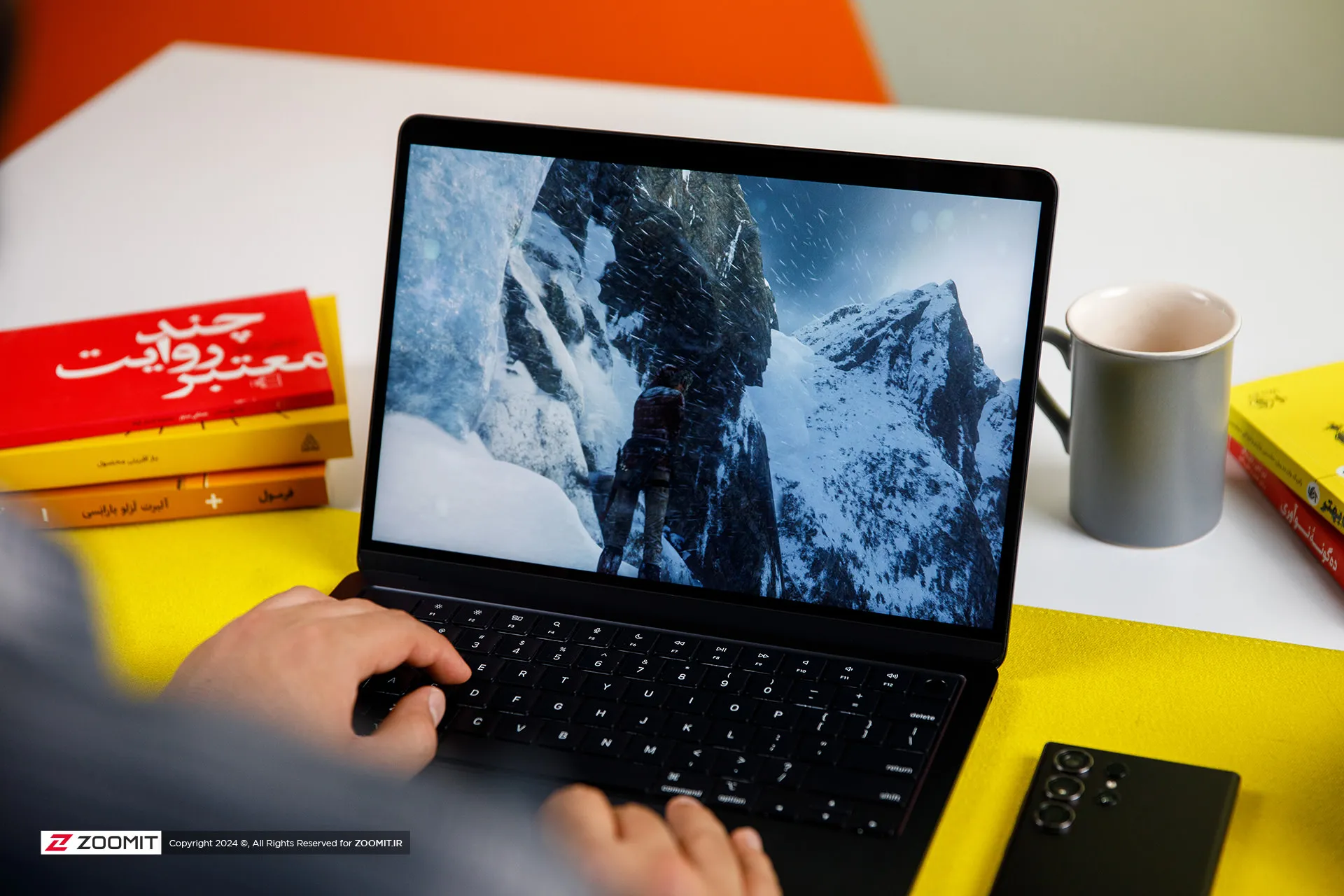
Apple laptops have a stunning performance in terms of web surfing experience and M3 has taken this performance to a whole new level; MacBook Air 2024 outperforms Asus Ultrabook 2024 with a 65% difference in the Zoomit web browsing test. The stunning superiority of the MacBook Air shows that Apple’s laptop offers faster and smoother performance on the web.
Apple’s new ultrabook appears in almost the same level of computing processing as the last generation. It seems that M3 remains behind its Intel competitor by 25% in the processes that take place on the basis of the OpenCL framework; But instead, thanks to Apple’s exclusive Metal framework, it surpasses the performance of Core Ultra 7 in processes based on Vulkan, with a difference of 10%.
Let’s skip the benchmarks and talk about how the MacBook Air 2024 performs in professional software and games. For this, we considered Photoshop and Premiere Pro software, Python code execution, and the Rise of the Tomb Raider game.
The set of games available for macOS is much more limited than for Windows; However, thanks to the tool that Apple introduced at WWDC 2023 for porting Windows games (Game Porting Toolkit), some were able to run titles such as Medium and Cyberpunk 2077 on Macs with powerful graphics processors such as the M2 Max, and it is hoped that in the future, this same tool, pave the way for more games to be released.
We were able to run the old game Rise of the Tomb Raider at 1200p resolution, High graphics settings and an average frame rate of 50.5 fps, which shows an advantage of about 25 percent of the M3 compared to the M2.
 MacBook Air M3 performance while playing Rise of the Tomb Raider game
MacBook Air M3 performance while playing Rise of the Tomb Raider game
MacBook Air M3 works about 10 to 20 percent faster than its two previous generations and ZenBook 14 while using Photoshop software for tasks such as resizing large photos and implementing the blur effect or lens correction.
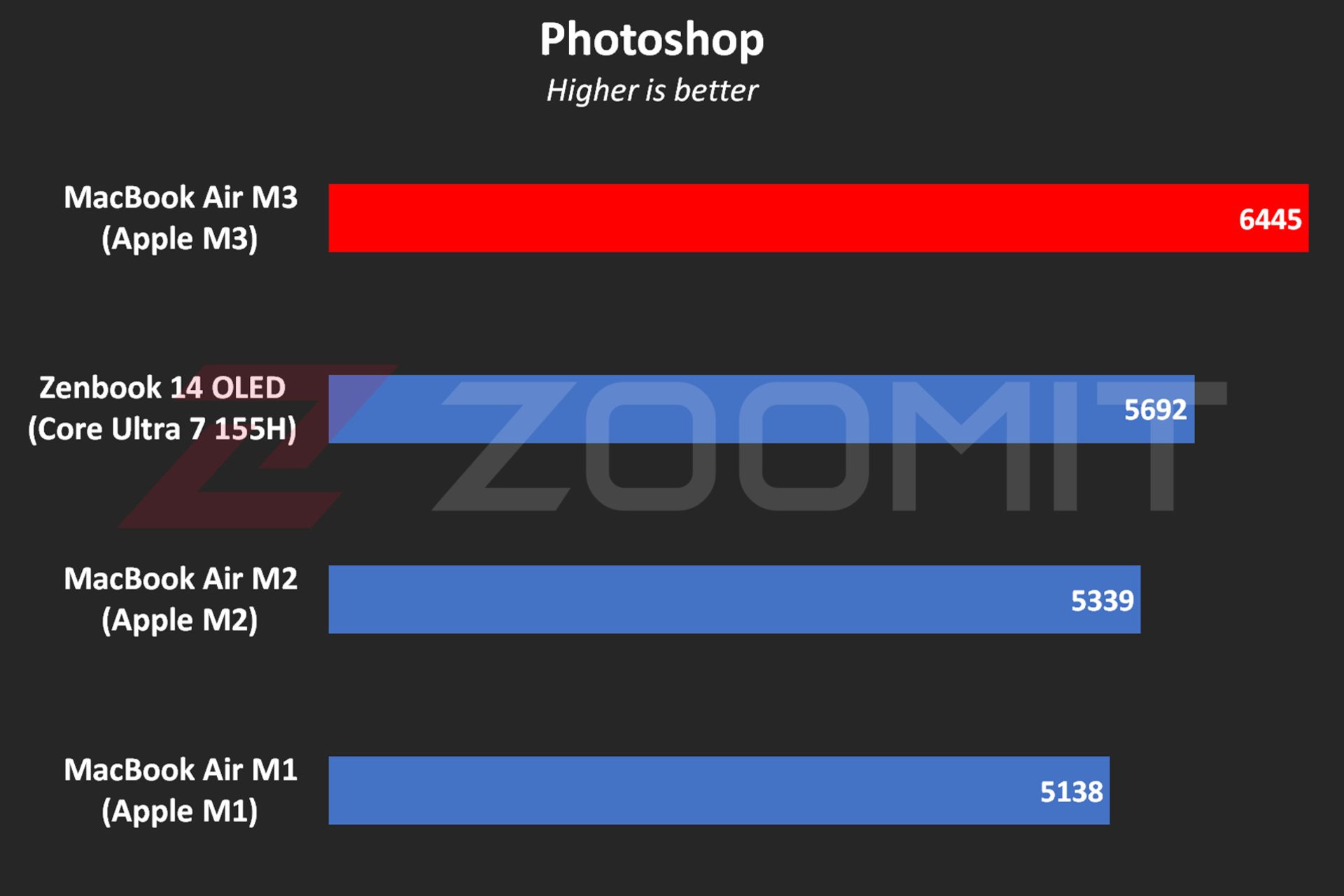 MacBook Air M3 performance in Photoshop software
MacBook Air M3 performance in Photoshop software
In Premier Pro software, while performing tasks such as blur effect implementation, image sharpening, or 4K video output, the performance of the device is 20-30% better than the MacBook Air M2 and Zenbook 14.
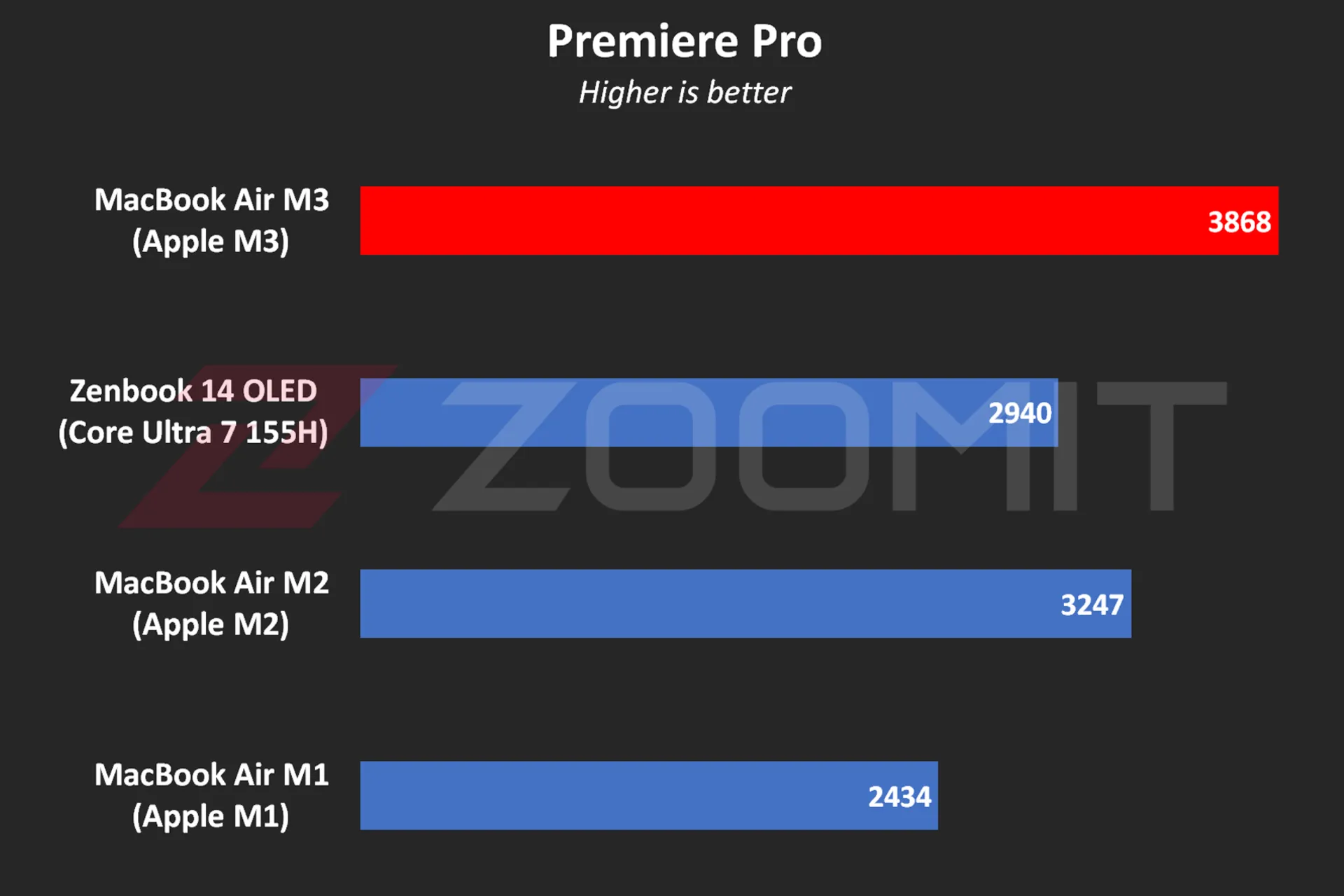 Performance of MacBook Air M3 in Premier Pro software
Performance of MacBook Air M3 in Premier Pro software
Note that in software such as Premiere Pro, where we are dealing with heavy projects, the low RAM overshadows the performance level and you may even get stuck in scenarios like editing 4K videos. Next, we will talk about the MacBook Air M3 RAM.
The MacBook Air was able to run Zoomit’s Python code in about 45 seconds, which is about 13 seconds faster than the M2 and 33 percent faster than the M1.
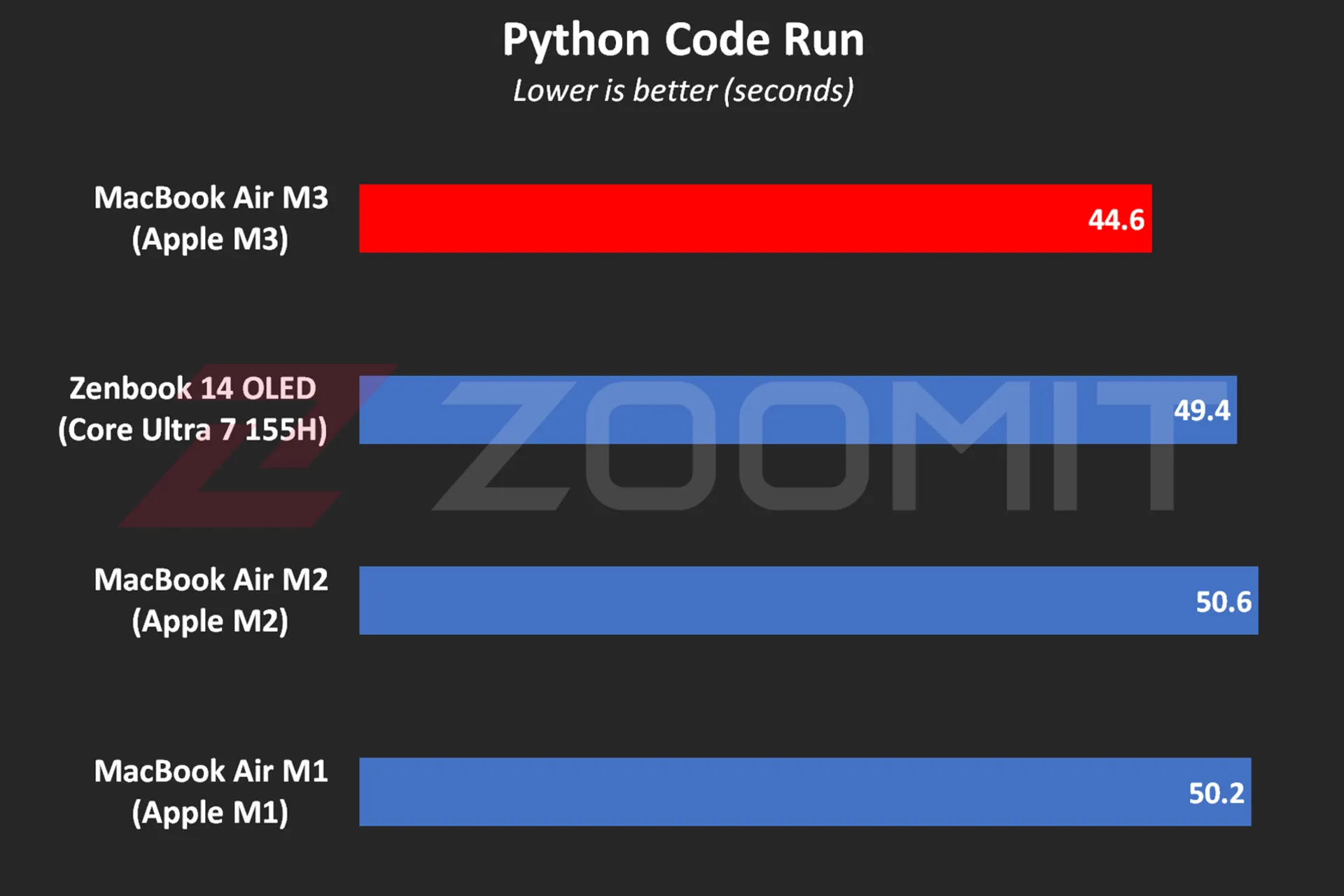 MacBook Air M3 performance while running Python code
MacBook Air M3 performance while running Python code
One of the most attractive features of MacBooks is that they work equally well, whether connected to electricity or relying on batteries; For example, when running Python code while plugged in, the MacBook Air M3 beats the ZenBook 14 by just 4 seconds; But by disconnecting the laptops from the electricity and Zenbook’s performance drop, the time difference reaches 11 seconds!
In addition to running Python code, the MacBook Air also displays similar performance in other software in both plugged-in and battery-powered states; In the table below, you can see the difference in performance of MacBook Air M3 in Plugged and UnPlugged modes in a number of users:
|
Performance of MacBook Air 2024 when connected to electricity and with battery |
||
|---|---|---|
|
Test/Performance |
Plugged result |
Result UnPlugged |
|
CineBench 2024 (MultiCore) |
574 |
573 |
|
Speedometer 2.1 |
680 |
681 |
|
Photoshop |
6488 |
6588 |
|
Premiere Pro |
3868 |
3881 |
|
Python |
44.6 seconds |
44.7 seconds |
In the MacBook Air 2022 review, we said that the lack of an active cooling system (fan) makes this ultrabook unable to provide stable performance under continuous processing loads. Now it’s time for MacBook Air 2024 with the same cooling system; But this time with a more optimized chip, it will be wider. Does the MacBook Air M3 offer stable performance?
To evaluate the cooling system, the performance stability level and measure the power consumption and other parameters of the MacBook Air M3, we first ran the CineBench R23 multi-core test on the device for 30 minutes consecutively in both power-connected and battery-based modes; Then we went to the 20-minute Wild Life Extreme test.
|
MacBook Air 2024 laptop performance under continuous processing load |
||||
|---|---|---|---|---|
|
Laptop status |
CPU score at first |
CPU score after 30 minutes |
GPU score first |
GPU score after 20 minutes |
|
Connected to electricity |
9872 |
7841 |
6989 |
5207 |
|
with battery |
9833 |
8322 |
6996 |
5271 |
MacBook Air M3 shows more or less the same behavior whether in Plugged or UnPlugged mode; After 30 minutes, the CPU performance drops by about 15-20%, and in a 20-minute graphics processing load, the GPU drops by 25%.
Contrary to the numbers stated in the technical specifications of the M3 chip, the MacBook Air 2024, whether in multi-core or single-core processing, never reaches the frequency of 4.05 GHz in powerful cores; In my measurements, the frequency of the most powerful cores in the multi-core test remained at 3.7 GHz for a few seconds; But it immediately begins the gradual process of decline and reaches below 2.5 GHz from the 10th minute, which is lower than the stable 2.75 GHz frequency of low-power cores!
Read more: Asus Zenbook 14 OLED laptop review
 CPU frequency in MacBook Air M3
CPU frequency in MacBook Air M3
The frequency drop process starts when the temperature of the hottest point of the chip reaches 103 degrees Celsius; It seems that Apple has adopted a more conservative strategy this year; Because in MacBook Air M2, the maximum temperature of the chip reaches 109 degrees Celsius. The temperature of 103 degrees of the chip continues for 5-6 minutes and then, thanks to the frequency drop, it decreases to the range below 90 degrees Celsius.
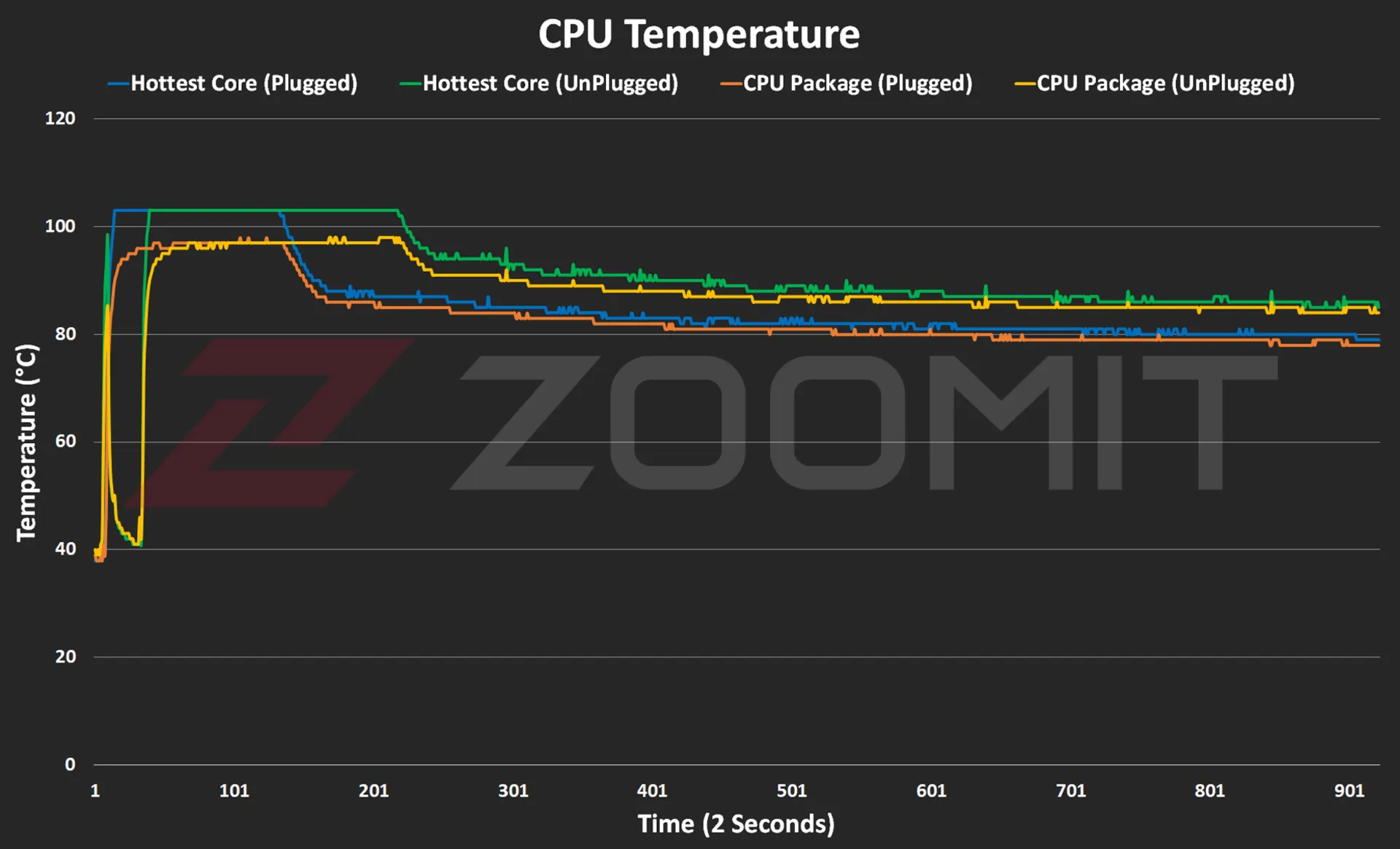 CPU temperature on MacBook Air M3
CPU temperature on MacBook Air M3
The temperature of the laptop body rises to 46-47 degrees Celsius, especially in the upper area of the keyboard; But in general, the body heat is not such that you cannot continue working with the laptop.
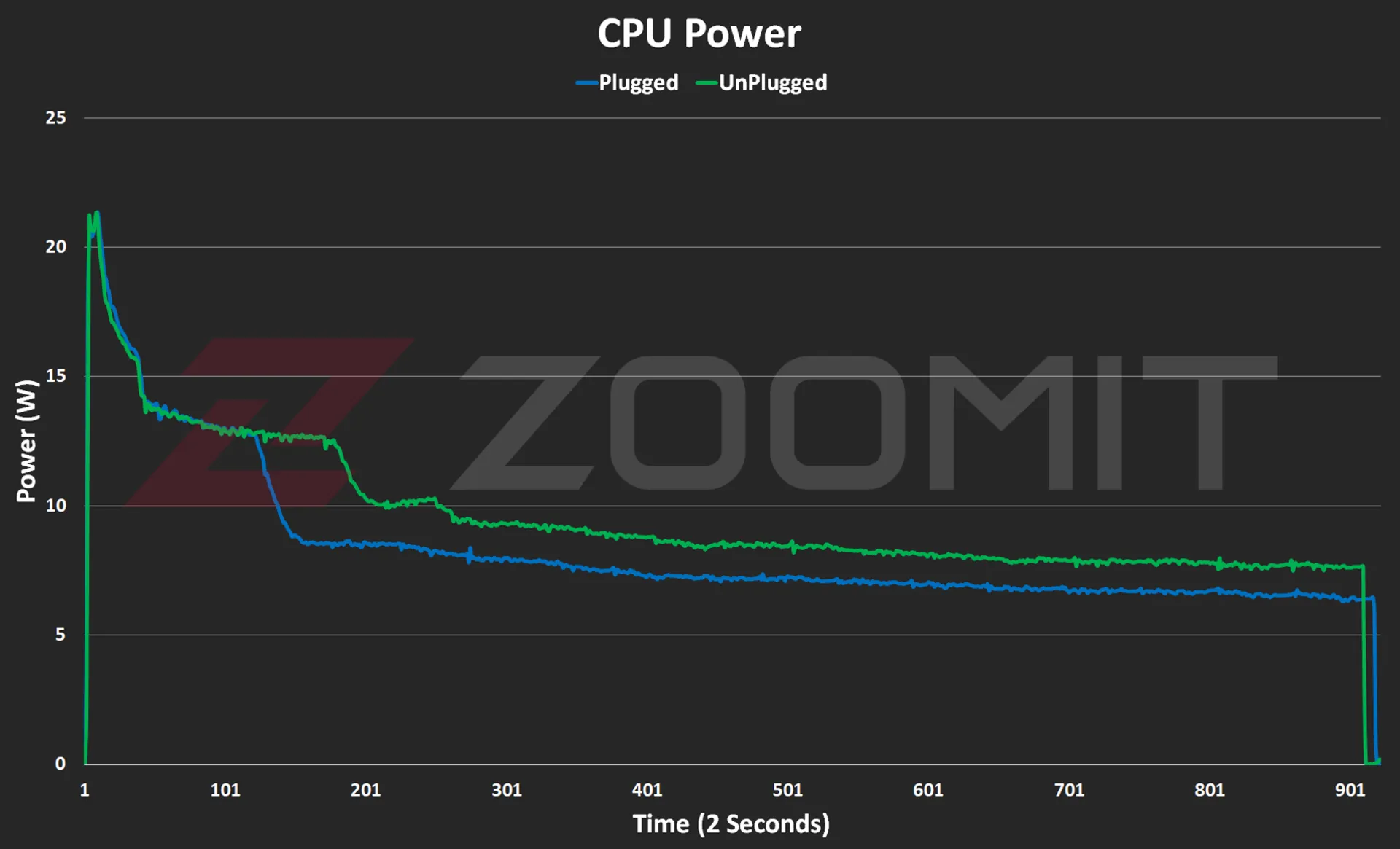 CPU consumption in MacBook Air M3
CPU consumption in MacBook Air M3
As you can see in the power consumption graph, the CPU consumes about 21 watts in the first few seconds; But as the body heats up, the power consumption gradually decreases and after a few minutes it reaches below 10 watts and reaches the range of 7-8 watts.
As you can see from the graphs below, the M3 GPU also follows a similar path to performance degradation from overheating the device.
 GPU consumption in MacBook Air M3
GPU consumption in MacBook Air M3
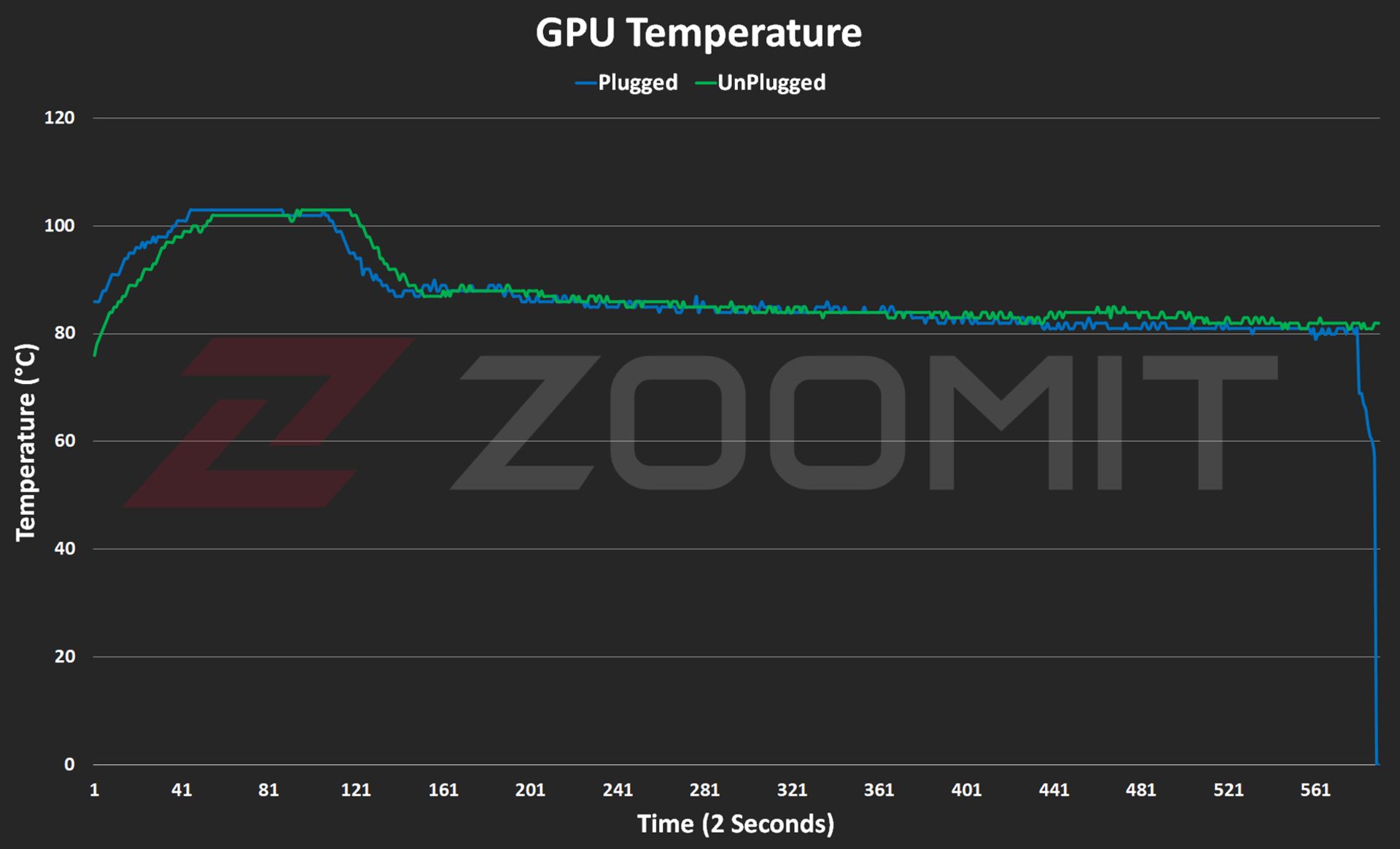
GPU temperature on MacBook Air M3

GPU frequency on MacBook Air M3
About 2-3 minutes after the start of graphic processing, in order to prevent the chip temperature from exceeding 103 degrees Celsius, the frequency of the GPU drops from about 1350 MHz and its power consumption from about 14 watts to 1000 MHz and below 8 watts. is approaching
My tests show that the MacBook Air M3 uses its powerful core stably with a frequency of about 3,750 MHz in single-core processing, this number is about 3,200 and 2,980 MHz in the MacBook Air M2 and MacBook Air M1 laptops, respectively.

In order to have a general outline and limits of architecture changes and IPC (the number of instructions executed per processing cycle), we can divide GeekBench’s single-core score by the chips’ single-core frequency; Note that this measure is not exact and only provides a general picture of the state of architectural changes. To accurately measure IPC, one should go to an expensive tool such as SPECView, which unfortunately is not available in Iran.
 Ratio of performance to CPU frequency
Ratio of performance to CPU frequency
To be more precise, what you see in the graph above is the ratio of single-core performance to CPU frequency in three generations of MacBook Air laptops with M1, M2, and M3 chips. In this chart, I have considered the MacBook Air M1 as a benchmark so that we can compare the other two chips relatively. The numbers say that the architectural changes in M3 have a 4 and 7 percent impact on the performance of this chip compared to M2 and M1, which is not a significant improvement.
In the graph below, you can see the ratio of M3’s performance to its power consumption compared to previous generations and the Core Ultra 7 155H chip. Note that the amount of power consumed by the chips is not stable and after a few seconds, it deviates from its maximum value; Therefore, the graph below was created by running CineBench R23 once and based on the average power consumption during the benchmark execution period, so that we can obtain the ratio of performance to power consumption in the best performance condition of the laptop.
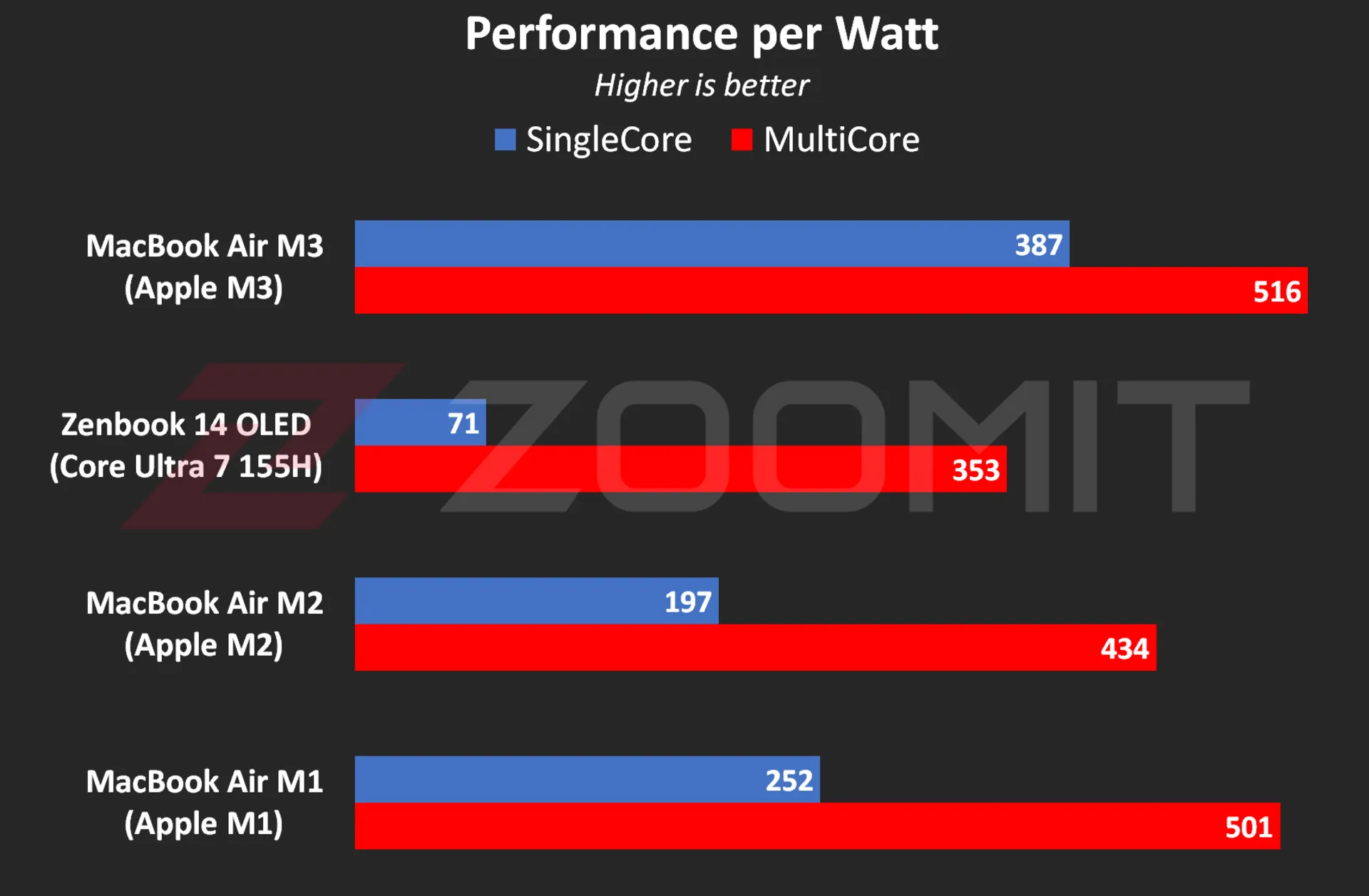 The ratio of performance to CPU power consumption
The ratio of performance to CPU power consumption
My measurements show that the M3 consumes an average of 4.9 and 19.1 watts when running the CineBench R23 single-core and multi-core benchmarks, respectively; While these numbers are equal to 8 and 20.2 watts for the M2 and 23 and 37.8 watts for the Core Ultra 7 155H, respectively, this shows the stunning efficiency of the M3; But if you consider the numbers obtained in the previous chart, you will realize that TSMC’s optimized manufacturing process has more influence on this amazing productivity than IPC and Apple’s architecture improvements.
The M3’s incredible efficiency also contributes to the MacBook Air M3’s excellent charging performance. Apple uses the same 52.6-watt-hour battery as the MacBook Air M2 in its new ultrabook and says that this laptop can charge for about 18 hours, just like the previous generation.
|
MacBook Air 2024 battery life compared to other laptops |
||||||
|---|---|---|---|---|---|---|
|
Laptop/Test |
Functional profile |
hardware |
Display |
Battery capacity |
Play offline video |
Everyday use |
|
Processor and graphics |
Dimensions, resolution, and refresh rate |
watt-hours |
720p Video |
PCMark 10 |
||
|
minute: hour |
minute: hour |
|||||
|
MacBook Air 2024 |
— |
Apple M3 8 core GPU |
13.6 inches and 60 Hz 1664 x 2560 pixels |
52.6 |
14:13 |
— |
|
Zenbook 14 |
Performance |
Core Ultra 7-155H Intel Arc |
14 inches and 120 Hz 1800 x 2880 pixels |
75 |
17:25 |
9:09 |
|
Galaxy Book 3 Ultra |
Performance |
Core i7-13700H RTX 4050 |
16 inches and 120 Hz 1880 x 2880 pixels |
76 |
11:00 |
6:21 |
|
MacBook Pro 2022 |
— |
Apple M2 10-core GPU |
13.3 inches and 60 Hz 1600 x 2560 pixels |
58.2 |
26:18 |
— |
|
MacBook Air 2022 |
— |
Apple M2 8 core GPU |
13.6 inches and 60 Hz 1664 x 2560 pixels |
52.6 |
14:11 |
— |
|
MacBook Pro 2020 |
— |
Apple M1 8 core GPU |
13.3 inches and 60 Hz 1600 x 2560 pixels |
58.2 |
16:47 |
— |
|
MacBook Pro 14-inch 2021 |
— |
M1 Max 24Core GPU |
14.2 inches and 120 Hz 1964 x 3024 pixels |
70 |
18:14 |
— |
The MacBook Air 2024 was able to play our benchmark HD video for a little over 14 hours, just like the previous generation, in standard Zoomit conditions, which includes 200 nits brightness (about 70% brightness) and flight mode activation, which is an impressive result; But it is about 3 hours less than the Asus Zenbook 14 Ultrabook with a larger 75 watt-hour battery.
… and 8GB RAM for everyone
Unfortunately, this year Apple did not fall short either, and in 2024, it released the basic version of its $1,100 ultrabook with 8 GB of RAM and 256 GB of SSD. If you buy from Apple’s website, you can order 16GB or 24GB of RAM and 512GB, 1TB, and 2TB of SSD; Of course, to go to each higher step, you have to pay 200 dollars more; For example, the MacBook Air 2024 with 16 GB RAM and 512 GB SSD will cost you about $1,500.
If the base version of the 8GB MacBook Air disappointed you, you can be glad that Apple has moved away from the cowardly strategy of using a NAND chip for the SSD of the base version of the MacBook Air, which ended up halving the read and write speeds, and this year all models with 2 sells NAND chips; The maximum speed of 4 and 3.5 GB/s for reading and writing is lower than Windows competitors; But it’s not bad either.
|
The average SSD speed of the base model MacBook Air 2024 compared to other MacBooks |
||
|---|---|---|
|
Models / Performance |
Sequential reading rate (UK gigabytes) |
Sequential write rate (UK gigabytes) |
|
MacBook Air M3 |
2.63 |
2.58 |
|
MacBook Air M2 |
1.03 |
2.32 |
|
MacBook Pro M1 |
2.28 |
2.46 |
There is a lot of debate on social networks about whether 8GB of RAM is sufficient or not. A number of Apple fans, with the logic that “MacBook RAM has high speed and memory swap technology is available to help SSD as RAM”, say that in many applications, 8 GB of RAM is enough; But you should pay attention to several points:
1. The data is not just traveling between the chip and RAM, which can compensate for the low capacity of the RAM by just having a high data exchange rate; In some applications, such as modeling or graphic work, several gigabytes of data may be stored in RAM for a relatively long time. Let’s say that the data exchange rate between the RAM and the M3 or M2 chip is no longer the best, and some chips such as the Core Ultra 7 155H offer a higher rate.
2. Memory swap is not a magical and new technology; The rest of the operating systems, such as Windows, also have similar technology; But it should be noted that swap memory reduces the useful life of SSD and the speed of SSD is not at the level of RAM that can fully play its role; For example, in MacBook Air M3, the data exchange rate between RAM and chip also reaches 102 GB/s; While the Mac SSD read and write rate is maybe one twentieth of this number.
3. Software tools are constantly developing, and their need for hardware resources, including RAM, also increases day by day. On the other hand, the user also buys the MacBook for a few years of use; Therefore, due to the lack of ability to upgrade RAM, one may face problems over time.
Aside from all the talk about Rome, a number of domestic sellers are also taking advantage of the opportunity; For example, Apple charges the same amount for a MacBook Air with 16 GB of RAM and 256 GB of SSD as for an 8 | 512 GB considered; But in Iran, configuring MacBook with more RAM is much more expensive than configuring with more SSD.
MacBook Air M3; Attractive and not very valuable
The MacBook Air M3 is by no means a bad product; But what makes buying this ultrabook illogical is the great value of its predecessors, especially the MacBook Air M1, especially if we consider their significant price difference.
For a person who does not have a laptop and is looking for a compact and well-made ultrabook for daily and light use, the base model of MacBook Air M1, which is currently sold at a price of 47-48 million Tomans, is a very desirable option; A device with an integrated metal body, a high-quality display, a very good keyboard and trackpad, excellent charging and fast performance that meets all the needs of an individual with daily use, journalism or light content production; Without the need to take an irrational action, about 25 million Tomans more will be spent to buy M3.
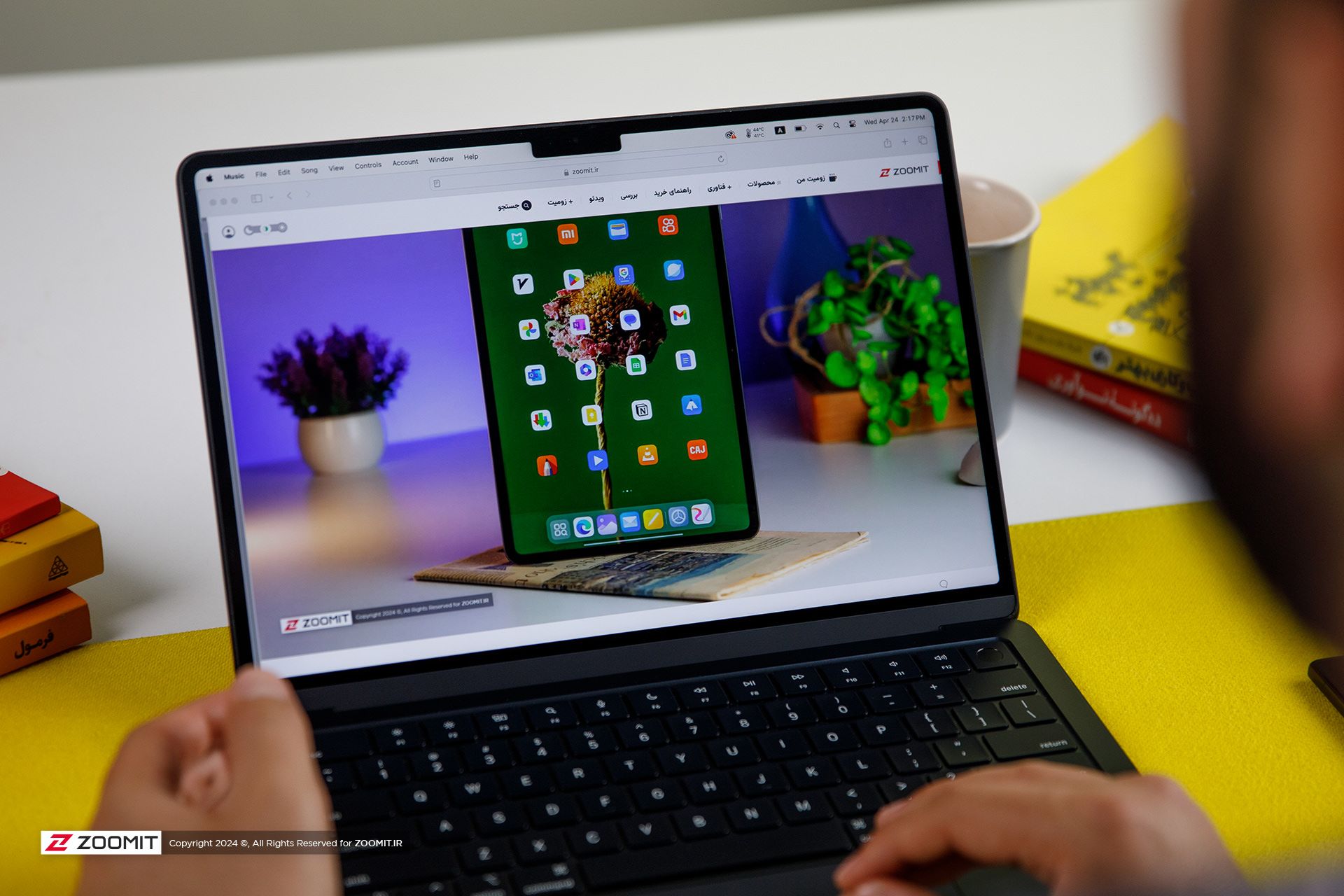
A person who already has a MacBook Air M2 and uses it for daily use should not go for the MacBook Air M3; Because it will not experience any significant changes; Except for the faster SSD, which is hardly noticeable in everyday use. For a current Mac M1 user, it might make more sense to upgrade to the M3.
For people who use laptops for tasks such as programming or video editing, the 8GB version of the MacBook Air M3 is not really a rational choice. If these people prefer macOS, it is better to go for used models with a budget of 70-75 million tomans, such as M1 Pro with 16 GB RAM, or if they are comfortable with Windows, high-quality options such as HP Envy with Core i9-13900H processor. And 16 GB of RAM will be a reasonable option for them.


What are the obstacles on the way for humans to reach Mars?


Unveiling of OpenAI new artificial intelligence capabilities


Samsung S95B OLED TV review


Discovery of the brain circuit that manages inflammation


History of the world; From the Big Bang to the creation of the planet Earth


Xiaomi Pad 6S Pro review


Is Telegram really safe?


The biography of Pavel Durov


AI PC; revolutionary technology of the future?


Samsung Galaxy A55 vs Galaxy S23 FE
Popular
-



 Technology10 months ago
Technology10 months agoWho has checked our Whatsapp profile viewed my Whatsapp August 2023
-



 Technology11 months ago
Technology11 months agoHow to use ChatGPT on Android and iOS
-



 Technology10 months ago
Technology10 months agoSecond WhatsApp , how to install and download dual WhatsApp August 2023
-



 Technology11 months ago
Technology11 months agoThe best Android tablets 2023, buying guide
-



 AI1 year ago
AI1 year agoUber replaces human drivers with robots
-



 Humans1 year ago
Humans1 year agoCell Rover analyzes the inside of cells without destroying them
-



 Technology11 months ago
Technology11 months agoThe best photography cameras 2023, buying guide and price
-



 Technology11 months ago
Technology11 months agoHow to prevent automatic download of applications on Samsung phones


























































